Video shows SpaceX Starship explode at test site
Eyewitness video shows SpaceX’s Starship 36 erupting in a huge fireball during a ground test in Texas.
Source link
Eyewitness video shows SpaceX’s Starship 36 erupting in a huge fireball during a ground test in Texas.
Source link
The Lucas Museum of Narrative Art, rising on what used to be a parking lot in Exposition Park in downtown L.A., is devoted to visual storytelling: the comics of Charles M. Schulz (“Peanuts”) and Alex Raymond (“Flash Gordon”), movie concept art by Neal Adams (“Batman”) and Ralph McQuarrie (“Star Wars”), paintings by Frida Kahlo and Jacob Lawrence, photography by Gordon Parks and Dorothea Lange, illustrations by Norman Rockwell and N.C. Wyeth.
So when George Lucas and wife Mellody Hobson chose Mia Lehrer and her L.A. firm, Studio-MLA, to design the 11 acres of landscape around — and on top of — MAD Architects’ swirling, otherworldly, billion-dollar building, the driving forces behind the Lucas Museum made it clear that the landscape had to tell a story too.
Lehrer and her team studied how directors, illustrators and painters use topography to help amplify, among other things, emotion, sequence and storyline.
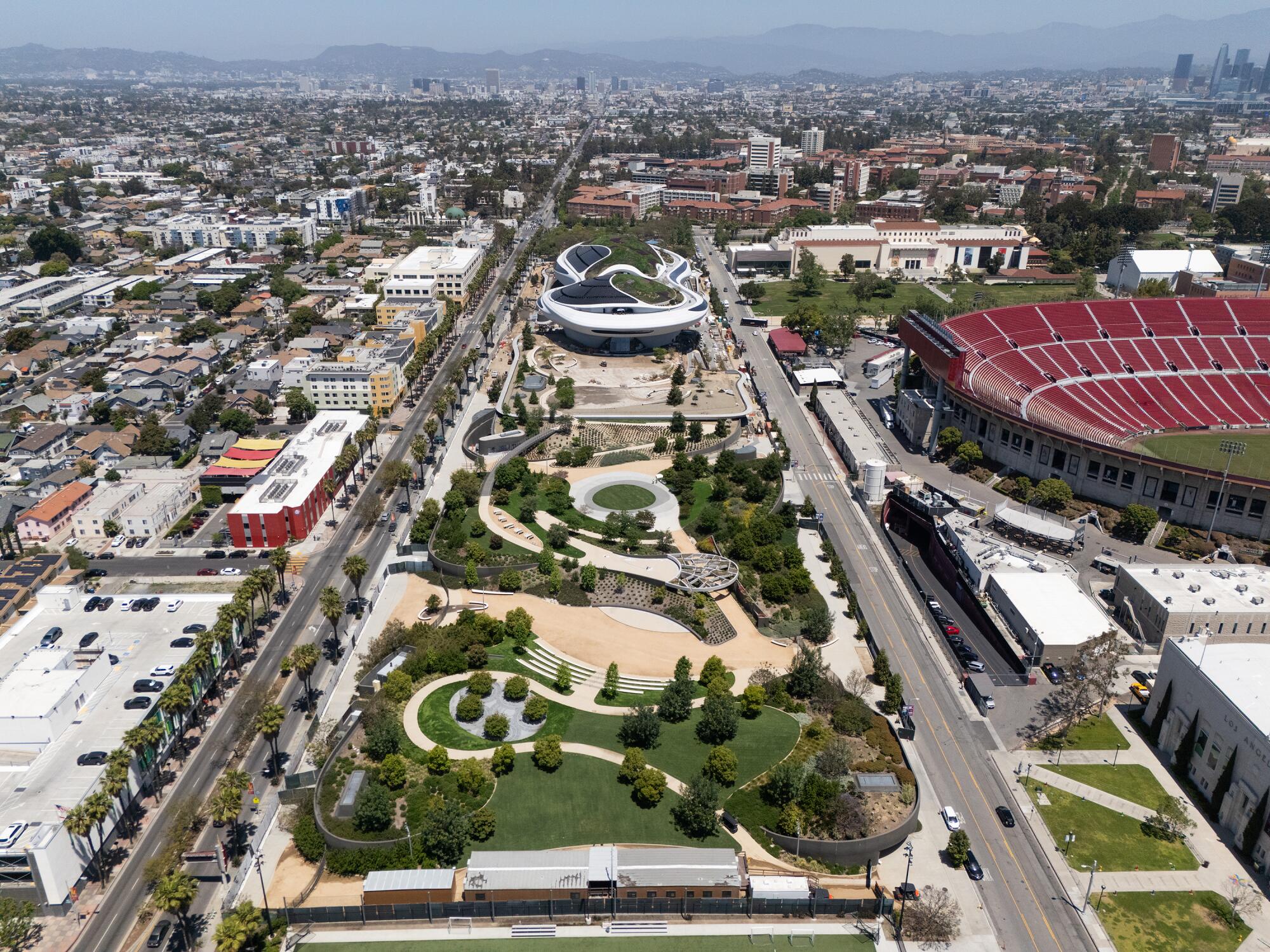
A long stretch of park space extends from the Lucas Museum of Narrative Art, which sits next to the Los Angeles Memorial Coliseum.
(Myung J. Chun / Los Angeles Times)
“We looked at the landscapes of myths and movies,” said Kush Parekh, a principal at Studio-MLA. “How do you take someone on a journey through space? How does the terrain change the story — and how can it be the story?”
The result — which feels surprisingly grown-in even though the museum won’t open until next year — is a sinuous, eclectic landscape that unfolds in discrete vignettes, all promoting exploration and distinct experience. Each zone contains varied textures, colors, scales and often framed views. A shaded walkway curls along a meandering meadow and lifts you toward a hilly canyon. A footbridge carries you above a developing conifer thicket. A plant-covered trellis, known as “the hanging garden,” provides a more compressed moment of pause. The environment, like a good story, continually shifts tone and tempo.
“It’s episodic,” Parekh said. “Each biome reveals something new, each path hints at what’s ahead without giving it away.”
A key theme of the story is the diverse terrain of California — a place that, in Lehrer’s words, “contains more varied environments in a single day’s drive than most countries do in a week.” Foothills and valleys, groves and canyons, even the mesas, plateaus and plains of the Sierra and the Central Valley — Lehrer calls all of it a “choreography of place.”
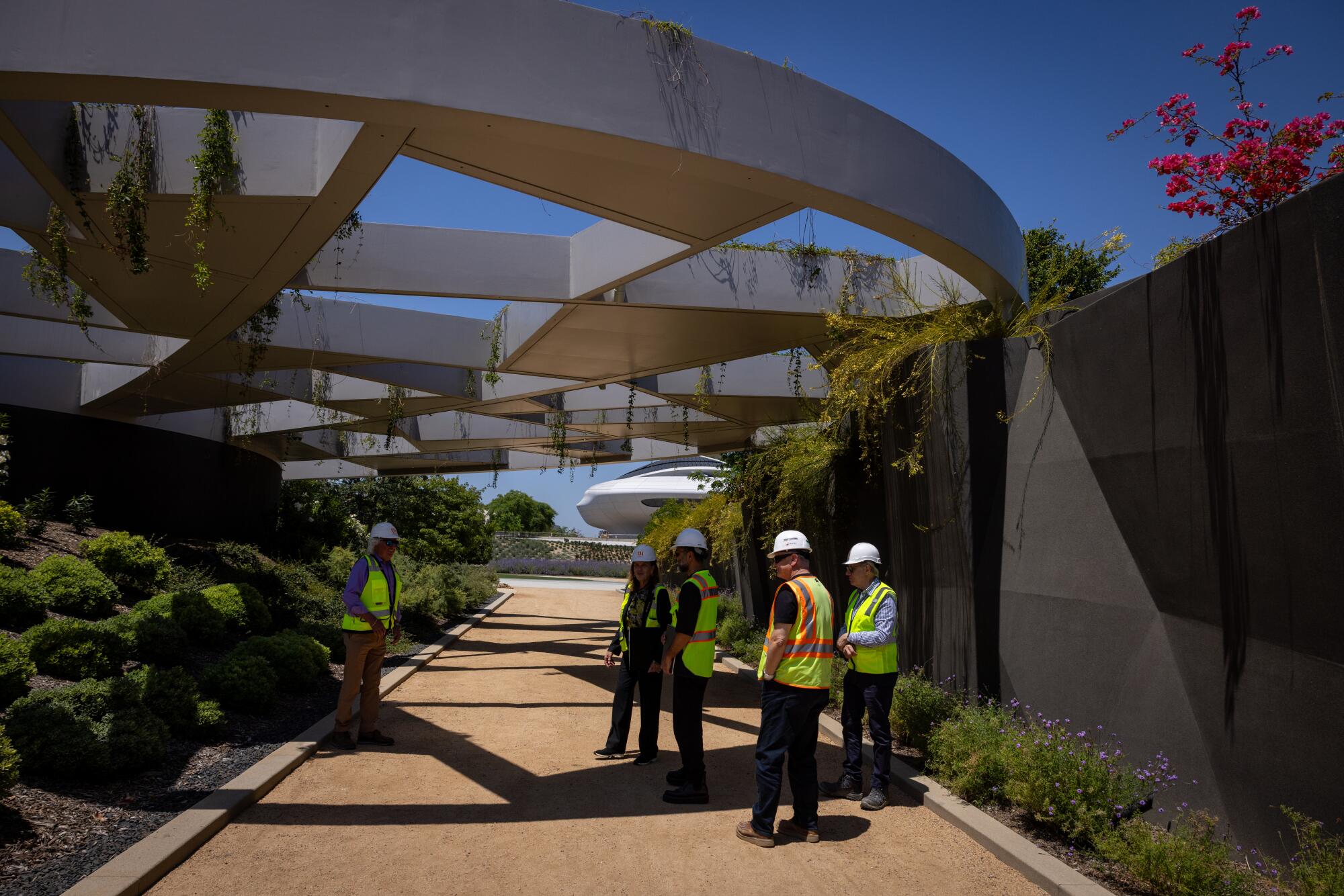
Lucas Museum staff and design team stand under the trellis of “the hanging garden.”
Another, more subtle, layer of this narrative is time. Plantings were laid out to bloom in different seasons and in different places. Bright yellow “Safari Goldstrike” leucadendron, edging the meadow and canyon, come alive in late winter and early spring. Tall jacarandas, spied from a foothills overlook, emerge then quickly disappear. “Bee’s Bliss” sage, lying low in the oak woodland, turn lavender blue in the early summer. Something is always emerging, something else fading.
“Every month, every visit, feels different,” Parekh said.
Even the alpine-inspired plantings cladding the museum’s roof — colorful wildflowers, long sweeping grasses and coarse scrubs, all chosen for their hardiness, lightness and shallow roots — follow this rhythm.
“They’re alive. They change. They move with the climate,” Lehrer said.

The landscape creates the illusion that some plantings run right up to the museum. Here, the black void on the underside of the building is the opening for a giant waterfall that will cascade to a pool below.
(Jason Armond / Los Angeles Times)
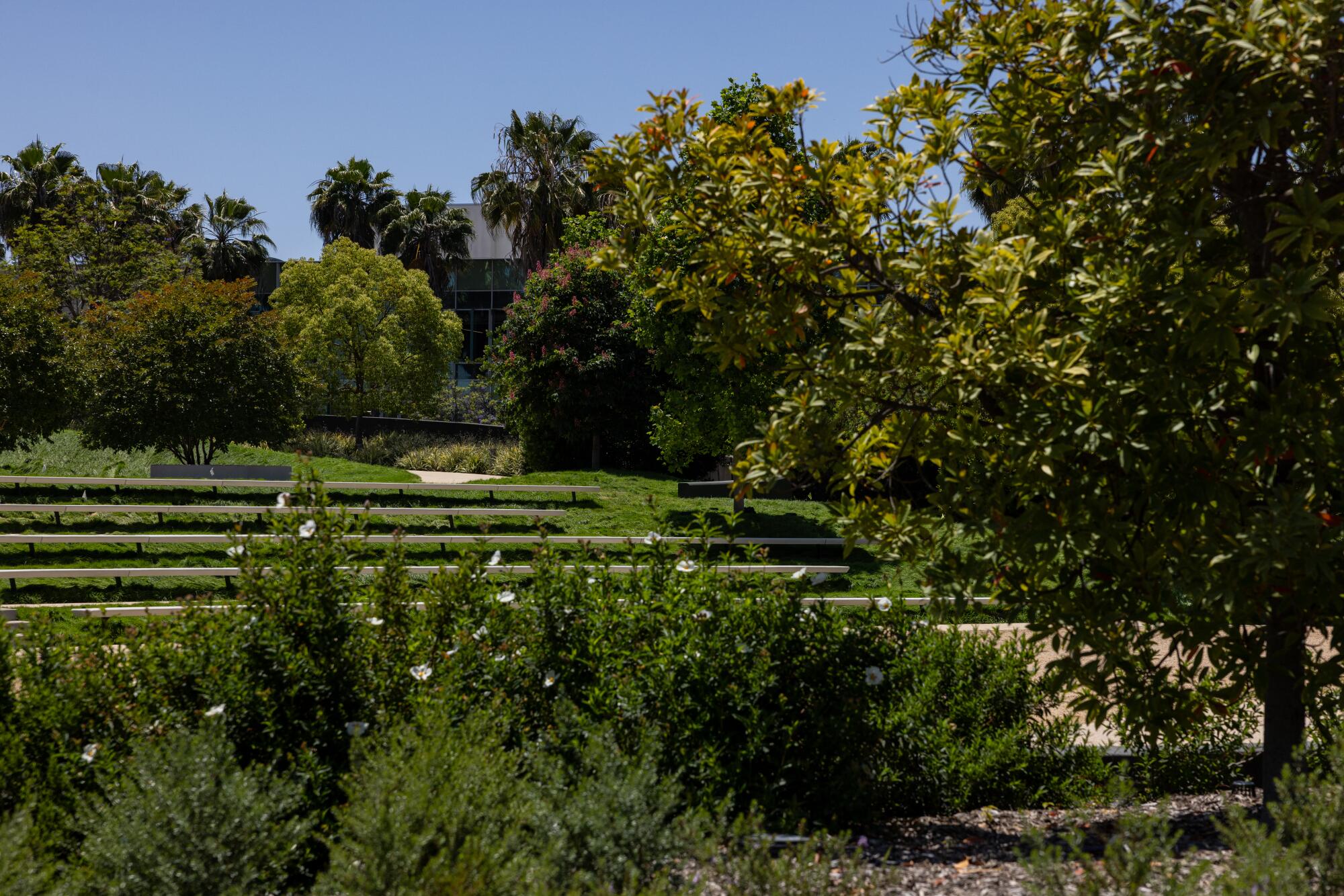
The grounds include the terraced seating of an amphitheater.
(Jason Armond / Los Angeles Times)
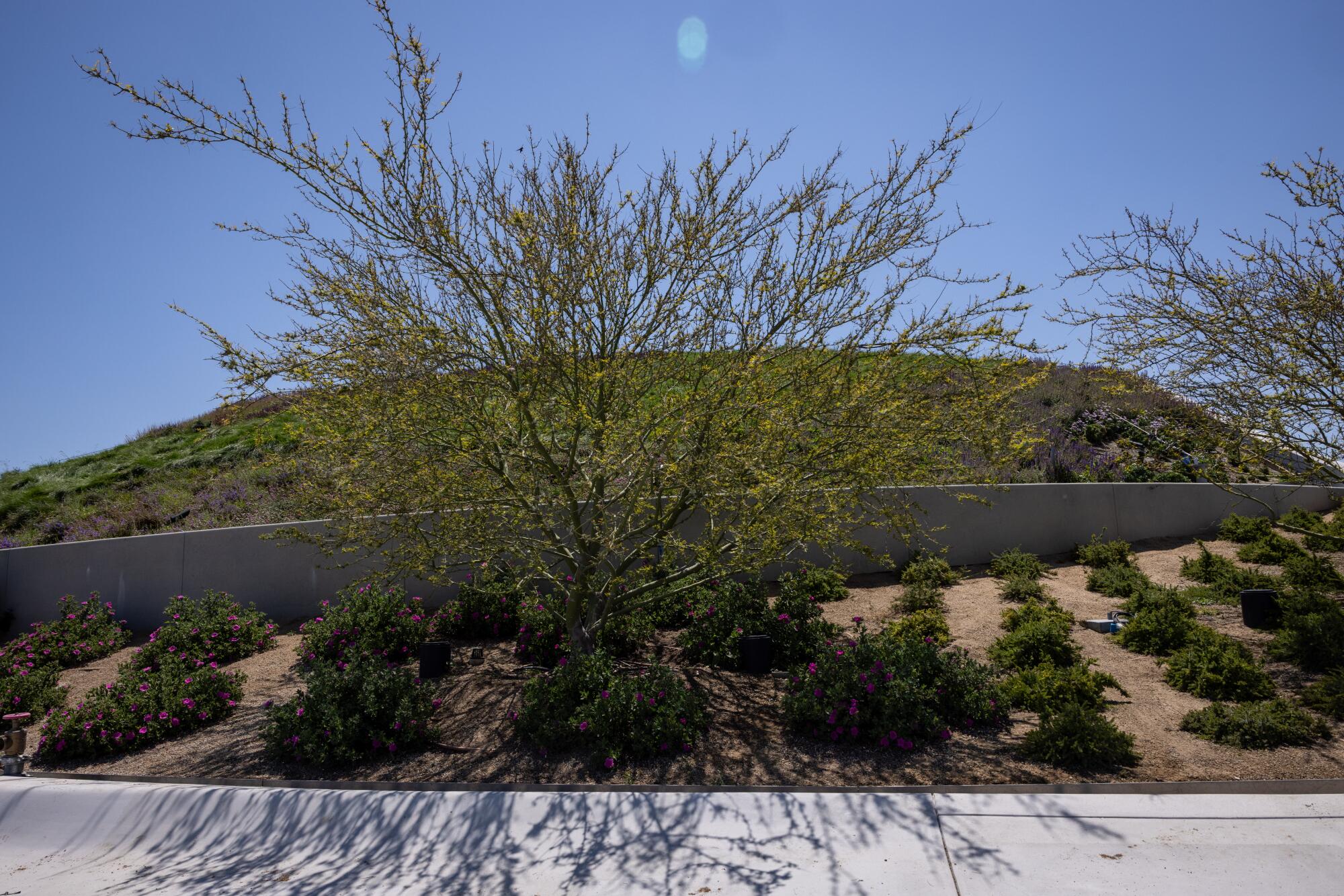
The plant palette includes low-water selections.
(Jason Armond / Los Angeles Times)
Amazingly, the rest of the landscape is a kind of green roof as well, sitting atop a 2,400-spot underground parking structure — available to those visiting the Lucas or any of Expo Park’s other institutions. Wedged between the greenery and the parking are thousands of foam blocks, mixed with soil and sculpted to form the landscape while minimizing weight on the building below.
“I wish I had invested in foam before we started this,” joked Angelo Garcia, president of Lucas Real Estate Holdings. “It’s everywhere. These mountains were created with foam.”
“It’s full-scale ecology sitting on top of a structural system,” noted Michael Siegel, senior principal at Stantec, the museum’s architect of record, responsible for its technical oversight and implementation.
“That’s how the best storytelling works,” Lehrer added. “You don’t see the mechanics. You just feel the effect.”
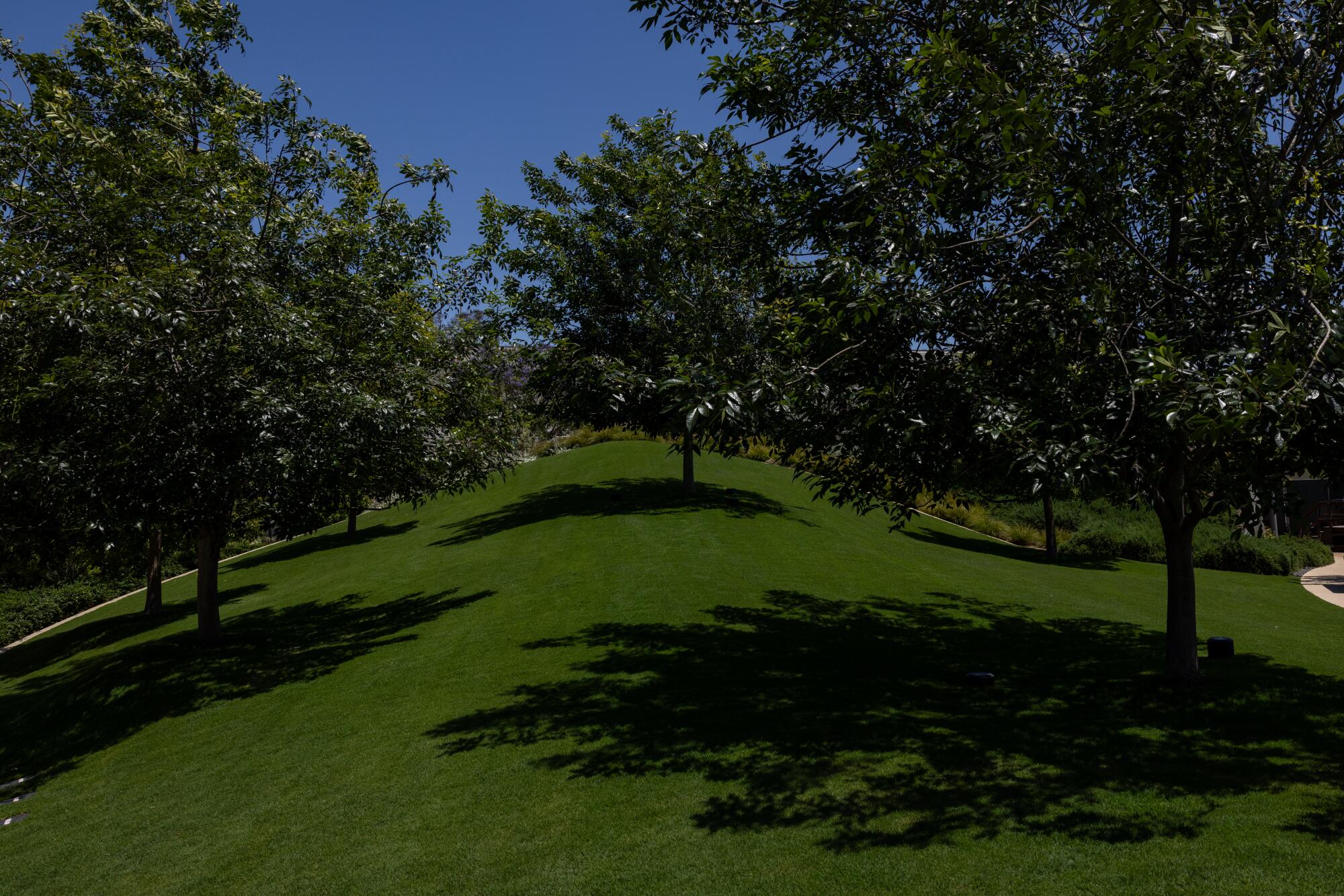
Foam blocks buried in the soil shape the terrain while minimizing weight on the parking structure below.
(Jason Armond / Los Angeles Times)
As you make your way through the rolling landscape, it becomes clear that it’s also crafted to meld with MAD’s sculptural design — a hovering, eroded form, itself inspired by the clouds, hills and other natural forms of Los Angeles.
“There’s a dialogue,” Garcia said.
Paths bend instead of cut; curving benches — cast in smooth, gently tapering concrete — echo the museum’s fiber-reinforced cement roofline. Bridges arc gently over bioswales and berms. Ramps rise like extensions of the building’s base. Paving stones reflect the color and texture of the museum’s facade.
“It was never landscape next to building,” Lehrer said. “It was building as landscape, and landscape as structure. One continuous form.”
Closer to the building, where a perimeter mass damper system that the design team has nicknamed the “moat” protects the museum from seismic activity, landscape nestles against, and seemingly under, the structure’s edges, further blurring the barrier between the two. Rows of mature trees being planted now will help soften the flanks. Vines will hang from the Lucas’ floating oculus, right above its entry court.
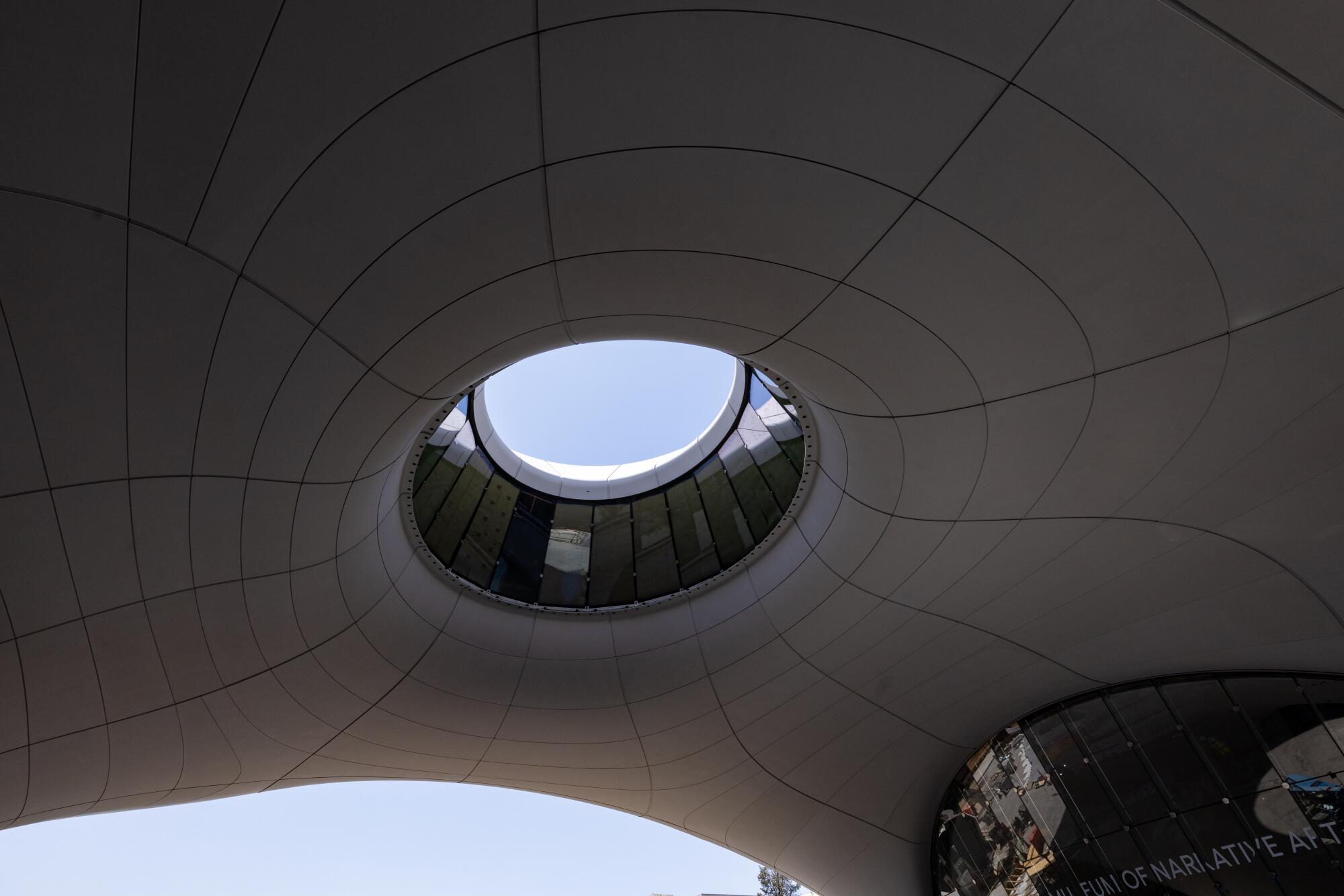
The building’s oculus eventually will have vines hanging from it.
(Jason Armond / Los Angeles Times)
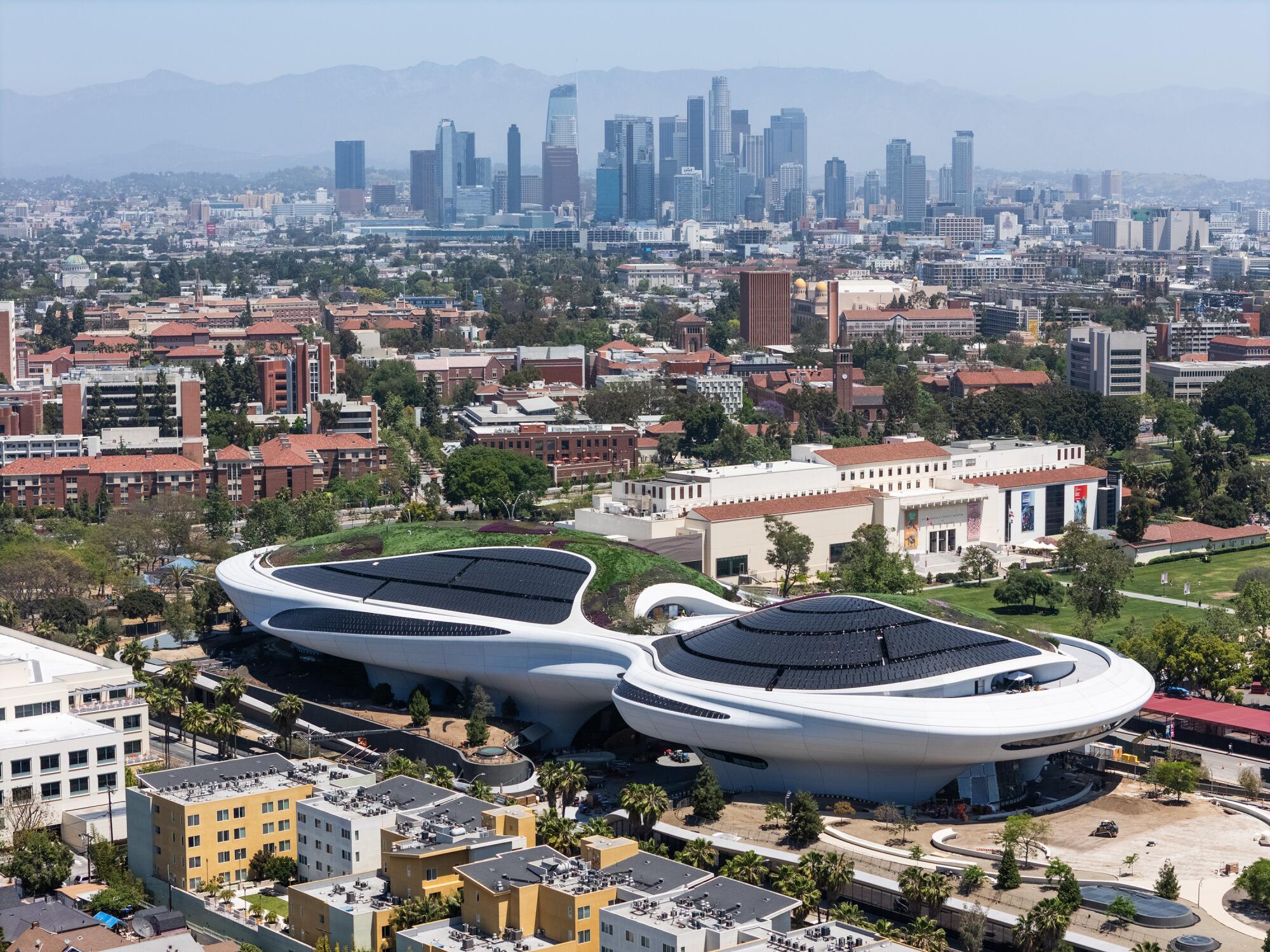
The Lucas Museum of Narrative Art rises in Exposition Park, its rooftop clad with solar panels and gardens, the skyline of downtown Los Angeles rising behind it.
(Myung J. Chun / Los Angeles Times)

A worker on the green rooftop of the museum.
(Jason Armond / Los Angeles Times)
The topography was designed to minimize environmental impact. Hundreds of plants, mostly native to the region, are drought-tolerant (or at least require little watering). A rain-harvesting system captures water for irrigation. And on the north edge of the museum will be “The Rain,” a waterfall that doubles as a passive cooling system, replacing traditional air-conditioning infrastructure. (Dozens of underground geothermal wells provide additional cooling.)
In this part of South L.A., park space is egregiously scarce, a remnant of redlining and disinvestment. This space — set to be open to the public without a ticket, from dawn to dusk — is a game changer, as is a massive green space on Expo Park’s south side that also replaces a surface parking lot and tops an underground garage. (That latter project has been delayed until after the 2028 Olympics.)
“It’s hotter, it’s denser and it’s long been overlooked. We wanted to change that,” Lehrer said of the area.
What was once a walled-off asphalt lot is a porous public space, linking Expo Park to the rest of the neighborhood via its four east-west pathways and opening connections on the north side to Jesse Brewer Jr. Park, which the Lucas Museum has paid to upgrade. The museum also funded the creation to the south of the new Soboroff Sports Field, which replaces a field that was adjacent to the site’s parking lot. The Lucas’ circular plaza and amphitheater with seating for hundreds, have the potential not only to host museum events but also to become popular community gathering spots.
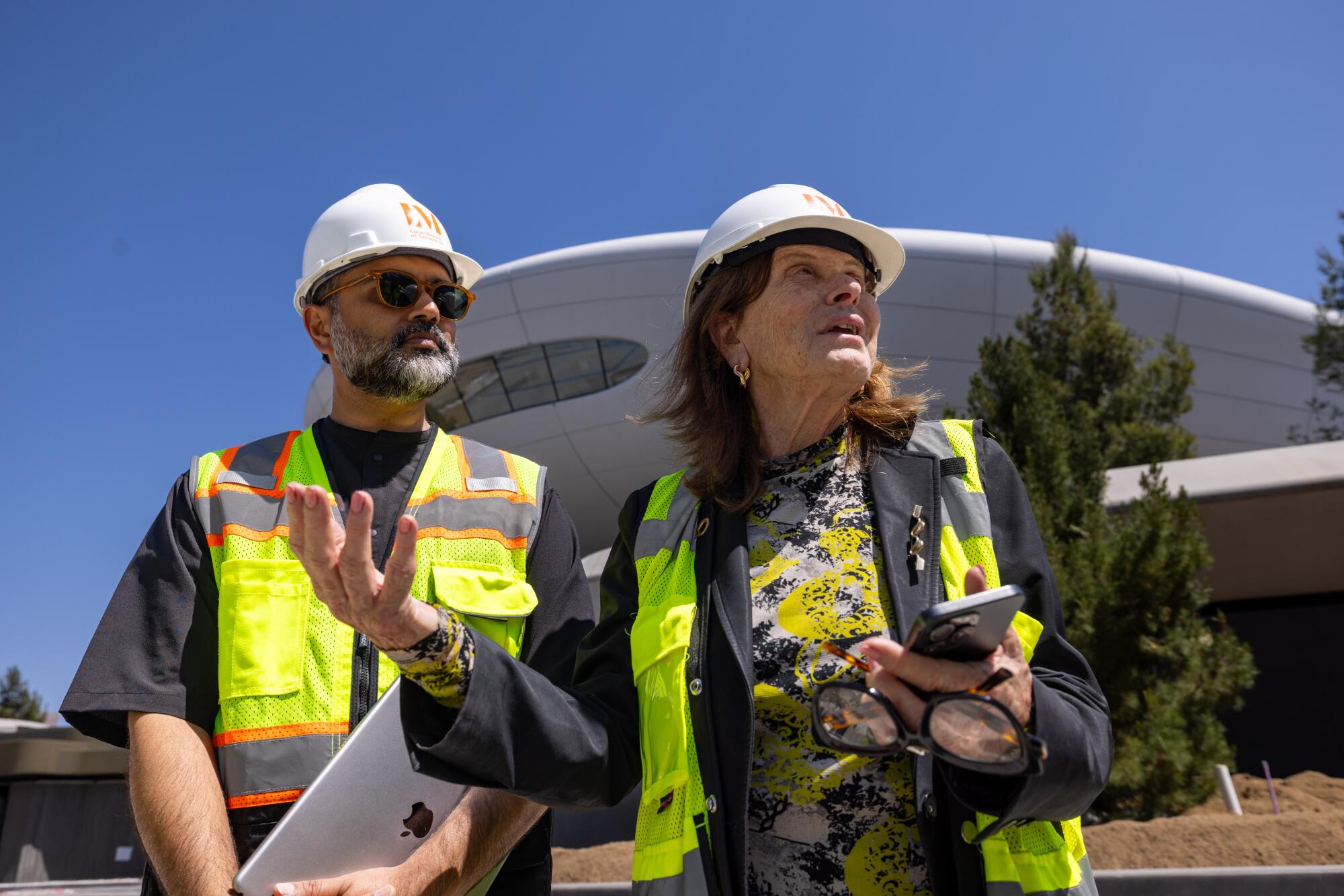
Kush Parekh, left, and Mia Lehrer of Studio-MLA.
(Jason Armond / Los Angeles Times)

Treetops rising along the museum’s curvaceous silhouette.
(Jason Armond / Los Angeles Times)
For Lehrer, the landscape is a convergence of civic and ecological ideas that she’s developed throughout her career — really ever since a chance encounter with the intricate original drawings for Central Park while she was studying at the Harvard Graduate School of Design spurred her to pivot from planning to landscape architecture. At this point, she’s created arguably more major new public spaces in Los Angeles than any other designer, including two vibrantly didactic landscapes at the adjacent Natural History Museum of Los Angeles, downtown’s 10-acre Vista Hermosa Park and the artfully layered grounds and lake surrounding SoFi Stadium.
“This brings everything together,” she said. “Design, ecology, storytelling, infrastructure, community. It’s the fullest expression of what landscape can be.”
Lehrer credits Lucas with not just permitting her to explore these ideas but encouraging her to push them further. Lucas supported the rare — and costly — installation of mature plantings. Usually the landscape is the last part of a building to emerge.
The progress in the grounds is a bright spot for the museum, which has been grappling with construction delays, the surprise departure of its executive director and, most recently, the layoffs of 15 full-time and seven part-time employees, part of a restructuring that a museum official said was “to ensure we open on time next year.”
As the new building accelerates toward that opening, the vision outside is becoming more clear.

George Lucas, center, wife Mellody Hobson and then-Mayor Eric Garcetti as the Lucas Museum began construction in 2019.
(Robert Gauthier / Los Angeles Times)
“To have an open-minded client, who gets landscape and also appreciates creativity, it’s rare,” Lehrer said. Lucas, who grew up on a farm in Modesto, has been developing the vineyards, gardens and olive groves of his Skywalker Ranch in Northern California for decades.
“I have always wanted to be surrounded by trees and nature,” Lucas said. “The museum’s backyard is meant to provide a respite in a hectic world.”
A president who built his reputation as a real estate mogul and TV personality, not through political office or military service. A cultural influencer and entrepreneur best known as the CEO of Tesla and SpaceX, he also leads companies like Neuralink and The Boring Company, both embroiled in a feud. An intriguing moment in politics, one that could steer the direction of public discourse and holds potential for both factionalism and authoritarian tendencies. Two political outsiders beefing in the political space. Perhaps, if both were real politicians, the first thing to say would be that in politics there are no permanent friends and no permanent enemies, only permanent interests. Since both are businessmen, perhaps the philosophy of supply and demand should take the lead.
One key area of tension is their vision for power and influence. Trump has traditionally sought loyalty and absolute control over his political base. Musk, on the other hand, champions a decentralized, free speech-centric internet and promotes what he calls “rational centrism.” Their feud exposes a broader struggle over who gets to define the conservative movement in the digital age. Is it career politicians like Trump or tech disruptors like Musk?
As the feud between Elon Musk and Donald Trump escalates, it signals a seismic shift in where power and influence now reside in America. Musk represents the rise of the tech oligarch—billionaires who command not only wealth but also control over critical digital infrastructure and artificial intelligence. In contrast, Trump embodies the traditional fusion of business interests and political power. This public clash reflects more than a personal rivalry; it marks a defining moment in history when unelected figures with vast digital reach are rivaling, and in some cases eclipsing, the authority of elected officials. At stake is the very foundation of American democracy.
The cultural impact is equally significant. In today’s fragmented media landscape, Musk owns and controls X (formerly Twitter), one of the most influential social media platforms. Trump, meanwhile, promotes his views through Truth Social, his own media venture. Their battles play out in real time across these platforms, often fueling misinformation, deepening tribal divides, and eroding a shared sense of truth. This dynamic contributes to a growing destabilization of democratic norms. The rise of personality-driven politics is not confined to the United States; it is a global trend, reshaping leadership and public discourse worldwide. As Musk and Trump dominate headlines, millions are drawn into a media spectacle that distracts from urgent challenges like climate change, economic inequality, healthcare reform, and global instability. In this new era of digital power, the question remains: who truly holds the reins of influence, and at what cost to democratic society?
Elon Musk’s companies play a pivotal role in the U.S. economy, particularly in the automotive, aerospace, and infrastructure sectors. Should President Donald Trump choose to launch a political or rhetorical campaign against Musk, it could prompt Republican policymakers to reassess their support for clean energy subsidies, government contracts, or regulatory leniency. At the same time, Musk’s significant influence over financial markets—including cryptocurrencies and tech stocks—means that any sustained public clash with Trump could spark market volatility, especially if investors anticipate political retaliation or regulatory changes.
Should this feud be prolonged, the two figures could have far-reaching implications for Silicon Valley and the broader culture of innovation. Elon Musk is widely regarded as a symbol of entrepreneurial ambition and visionary risk-taking. Should former President Trump cast him as a political adversary, it could politicize certain elements of the tech industry, potentially undermining bipartisan support for innovation-driven initiatives. On the other hand, such a clash might encourage other tech leaders to adopt more overt political positions, either aligning with Musk’s views or deliberately distancing themselves from his influence, thereby challenging the traditionally apolitical posture of the tech sector.
The cultural implications of such a feud could be profound. Elon Musk resonates with younger, tech-savvy audiences through memes, livestreams, and direct engagement on social media platforms. In contrast, Donald Trump appeals to an older demographic that emphasizes traditional values and nationalist rhetoric. A prolonged conflict between the two figures could highlight and deepen the generational and ideological divides in American society. As business and politics become increasingly performative and adversarial, the space for collaboration, empathy, and thoughtful public discourse may continue to shrink.
Ultimately, in a nation already grappling with deep polarization, media fragmentation, and widespread institutional mistrust, a public clash between Elon Musk and Donald Trump could intensify existing divisions. While such a feud may appear, at first glance, to be mere spectacle, its ripple effects could extend far beyond headlines, impacting politics, economics, culture, and technology. As highly influential figures, both Musk and Trump bear a responsibility that transcends their personal brands. Their actions and their conflicts resonate throughout American society, making the consequences of their feud not just personal, but profoundly national.
The failed mission comes two years after the Japanese start-up’s first moonshot ended in a crash landing.
A Japanese-made private lunar lander has crashed while attempting to touch down on the moon, with its makers officially declaring the mission a failure.
Tokyo-based company ispace said on Friday that its lander, named Resilience, dropped out of lunar orbit as planned and that the mission appeared to be going well.
But flight controllers lost contact with Resilience, which was carrying a mini rover, moments before its scheduled touchdown on the surface of the moon following an hourlong descent. Ground support was met with silence as they attempted to regain contact with the lander and after several hours declared the mission a failure.
The company’s livestream of the attempted landing then came to an abrupt end.
“We have to take seriously what happened,” ispace CEO and founder Takeshi Hakamada said after the failed mission, as he apologised to everyone who contributed.
This is the firm’s second failed attempt to soft land on the lunar surface, coming two years after the Japanese start-up’s first attempt to reach the moon ended in a crash landing.
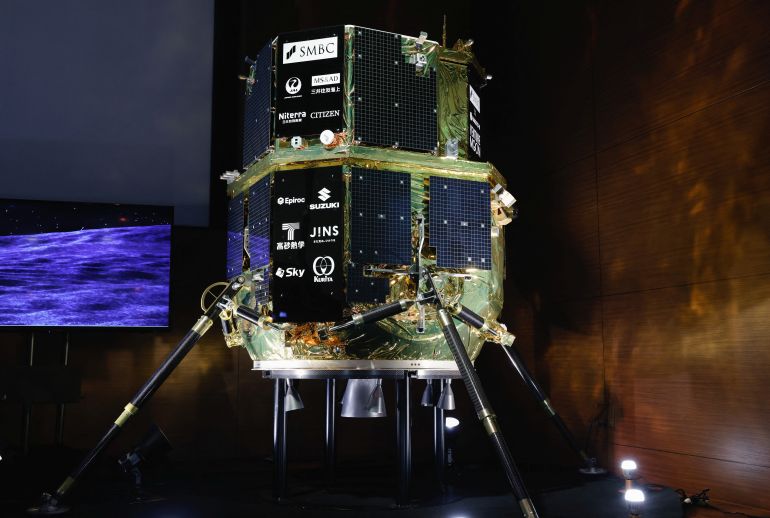
Launched in December 2022, the firm’s Hakuto-R Mission 1 reached lunar orbit but crashed during its final descent after an error caused the lander to believe it was lower than it actually was.
That mission’s successor, Resilience, was launched in January from Florida on a long, roundabout journey. It shared a ride on a SpaceX rocket with Firefly Aerospace’s Blue Ghost, which, upon reaching the moon first in March this year, made the US firm the first private entity to make a “fully successful” soft landing there.
The 2.3-metre (7.5-foot) Resilience lander was targeting the top of the moon, where the ispace team had chosen a flat area with few boulders in Mare Frigoris, or Sea of Cold, to land.
Resilience was expected to beam back pictures within hours of landing, before ispace’s European-built rover – named Tenacious – would have been lowered onto the lunar surface this weekend. The rover, made of carbon fibre-reinforced plastic and sporting a high-definition camera, would then have scouted out the area and scooped up lunar dirt for NASA.
Resilience was also carrying a toy-sized red house created by Swedish artist Mikael Genberg. Moonhouse, as the model Swedish-style cottage was called, was intended to be the moon’s first “building”, in a nod to Hakamada’s vision of humans living and working there as early as the 2040s.
But ispace’s now second failed landing has left the Japanese entrepreneur’s vision in doubt. The aerospace company’s next, much bigger lander is scheduled to launch by 2027 with NASA’s involvement.
Prior to Friday’s failed mission, the Japanese firm’s chief financial officer, Jumpei Nozaki, promised to continue its lunar quest regardless of the outcome.
But Jeremy Fix, chief engineer for ispace’s US subsidiary, said at a conference last month that the firm does not have “infinite funds” and cannot afford repeated failures.
Company officials said this latest failed mission cost less than the first one – which exceeded $100m – but declined to provide an exact figure.

June 2 (UPI) — Just days before the U.S. Senate was set to hold a confirmation vote, President Donald Trump withdrew Jared Isaacman’s nomination for NASA administrator, citing “prior associations.”
While the White House did not reveal specifics about why the nomination was being pulled, spokesperson Liz Huston confirmed Monday that the administration is looking for a new candidate to lead the agency.
“The administrator of NASA will help lead humanity into space and execute President Trump’s bold mission of planting the American flag on the planet Mars,” Huston said. “It’s essential that the next leader of NASA is in complete alignment with President Trump’s America First agenda and a replacement will be announced directly by President Trump soon.”
On Saturday, Trump revealed in a post on Truth Social that he was withdrawing the nomination “after a thorough review of prior associations,” without providing more details.
“I am hereby withdrawing the nomination of Jared Isaacman to head NASA. I will soon announce a new nominee, who will be mission aligned and will put America First in space,” Trump said.
Isaacman was expected to be confirmed this week after Senate Majority Leader John Thune, R-S.D., filed cloture on the nomination May 22. Several Democratic members of the Senate Commerce Committee had voted with Republicans in April to favorably report the nomination to the full Senate.
Isaacman, a commercial astronaut and billionaire businessman with ties to SpaceX, led the first all-civilian space flight into orbit and had received the endorsement of 28 former NASA astronauts. Sen. Tim Sheehy, R-Mont., criticized the administration’s decision to pull his nomination.
“Astronaut and successful businessman Isaacman was a strong choice by President Trump to lead NASA,” Sheet wrote in a post on X. “I was proud to introduce Jared at his hearing and strongly oppose efforts to derail his nomination.”
NASA released details Friday about its proposed fiscal year 2026 budget, which includes 25% cuts to the space agency’s overall spending. In April, Isaacman criticized reports that science funding could be cut by nearly 50%, saying it “does not appear to be an optimal outcome.”
After Trump’s weekend post, Isaacman — who was nominated last December — thanked the president and the Senate “who supported me throughout this journey.”
“The past six months have been enlightening and, honestly, a bit thrilling. I have gained a much deeper appreciation for the complexities of government and the weight our political leaders carry,” Isaacman wrote Saturday in a post on X.
“I have not flown my last mission — whatever form that may ultimately take — but I remain incredibly optimistic that humanity’s greatest spacefaring days lie ahead. I’ll always be grateful for this opportunity and cheering on our president and NASA as they lead us on the greatest adventure in human history.”
SAN FRANCISCO — In recent years, San Francisco’s image as a welcoming place for businesses has taken a hit.
Major tech companies such as Dropbox and Salesforce reduced footprints in the city by subleasing office space, while retailers including Nordstrom and Anthropologie pulled out of downtown. Social media firm X, formerly Twitter, vacated its Mid-Market headquarters for Texas, after owner Elon Musk complained about “dodging gangs of violent drug addicts just to get in and out of the building.”
While the city remains on the defensive, one bright spot has been a boom in artificial intelligence startups.
San Francisco’s 35.4% vacancy rate in the first quarter — among the highest in the nation — is expected to drop one to three percentage points in the third quarter thanks to AI companies expanding or opening new offices in the city, according to real estate brokerage firm JLL. The last time San Francisco’s vacancy rate dropped was in the fourth quarter, when it declined 0.2% — the first time since the COVID-19 pandemic, according to JLL.
“People wanted to count us out, and I think that was a bad bet,” said Mayor Daniel Lurie. “We’re seeing all of this because the ecosystem is better here in San Francisco than anywhere else in the world, and it’s really an exciting time.”
Five years ago, AI leases in San Francisco’s commercial real estate market were relatively sparse, with just two leases in 2020, according to JLL. But that’s since soared to 167 leases in the first quarter of 2025. The office footprint for AI companies has also surged, making up 4.8 million square feet in 2024, up from 2.6 million in 2022, JLL said.
“You need the talent base, you need the entrepreneur ecosystem, and you need the VC ecosystem,” said Alexander Quinn, senior director of economic research for JLL’s Northwest region. “So all those three things exist within the greater Bay Area, and that enables us to be the clear leader.”
AI firms are attracted to San Francisco because of the concentration of talent in the city, analysts said. The city is home to AI companies including ChatGPT maker OpenAI and Anthropic, known for the chatbot Claude, which in turn attract businesses that want to collaborate. The Bay Area is also home to universities that attract entrepreneurs and researchers, including UC Berkeley, UC San Francisco and Stanford University.
Venture capital companies are pouring money into AI, fueling office and staff growth. OpenAI landed last quarter the world’s largest venture capital deal, raising $40 billion, according to research firm CB Insights.
OpenAI leases about 1 million square feet of space across five different locations in the city and employs roughly 2,000 people in San Francisco. The company earlier this year opened its new headquarters in Mission Bay, leasing the space from Uber.
OpenAI began as a nonprofit research lab in 2015 and the people involved found their way to San Francisco for the same reason why earlier generations of technologists and people pushing the frontier in the United States are drawn to the city, said Chris Lehane, OpenAI’s vice president of global affairs in an interview.
“It is a place where, when you put out an idea, no matter how crazy it may seem at the time, or how unorthodox it may seem … San Francisco is the city where people don’t say, ‘That’s crazy,’” Lehane said. “They say, ‘That’s a really interesting idea. Let’s see if we can do it.’”
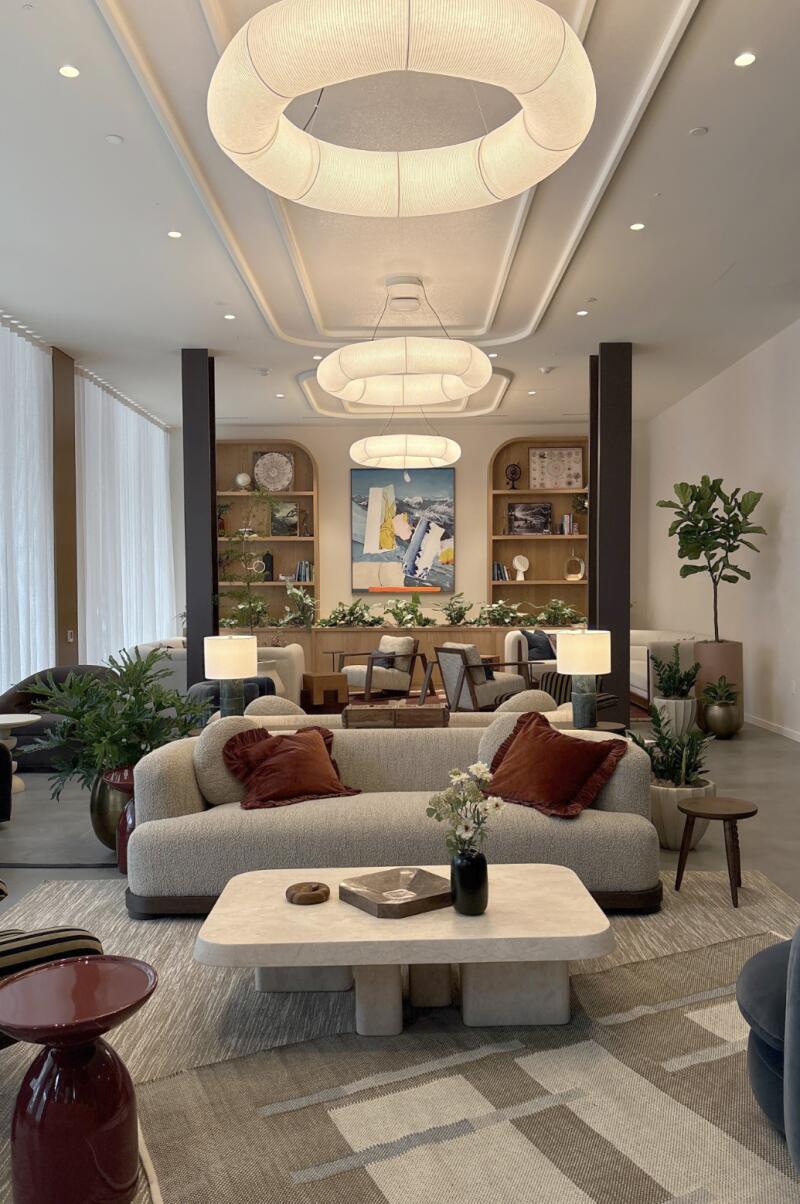


The interior of OpenAI’s new San Francisco headquarters in the Mission Bay neighborhood. (OpenAI)
Databricks, valued at $62 billion, is also expanding in San Francisco. Databricks in March announced it will move to a larger space in the Financial District next year, boosting its office footprint to 150,000 square feet and more than doubling its San Francisco staff in the next two years. It pledged to hold its annual Data + AI Summit in the city for five more years.
The company holds 57,934 square feet at its current San Francisco office in the Embarcadero, according to CoStar, which tracks real estate trends.
“San Francisco is a real talent magnet for AI talent,” said Databricks’ co-founder and vice president of engineering Patrick Wendell. “It’s a beautiful city for people to live and work in and so we really are just following where the employees are.”
Several years ago, Wendell said his company was considering whether to expand in San Francisco. At the time, it was unclear whether people would return to offices after the pandemic, and some businesses raised concerns about safety and cleanliness of San Francisco’s streets. Wendell said his company decided to invest more in the city after getting reassurances from city leaders.
“People are seeing an administration that is focused on public safety, clean streets and creating the conditions that also says that we’re open for business,” said Lurie, who defeated incumbent mayor London Breed last November by campaigning on public safety. “We’ve said from day one, we have to create the conditions for our arts and culture, for our small businesses and for our innovators and our entrepreneurs to thrive here.”
Laurel Arvanitidis, director of business development for San Francisco’s Office of Economic and Workforce Development, said that the city’s policy and tax reforms have helped attract and retain businesses in recent years, including an office tax credit that gives up to a $1-million credit for businesses that are new or relocating to San Francisco.
On Thursday, Lurie announced on social media that cryptocurrency exchange Coinbase is opening an office in San Francisco after leaving the city four years ago.
“We are excited to reopen an office in SF,” Coinbase Chief Executive Brian Armstrong wrote in response to the mayor’s social media post. “Still lots of work to do to improve the city (it was so badly run for many years) but your excellent work has not gone unnoticed, and we greatly appreciate it.”
Santa Clara-based Nvidia is also looking for San Francisco office space, according to a person familiar with the matter who declined to be named. The news was first reported by the San Francisco Chronicle. Nvidia, which also has California offices in San Dimas and Sunnyvale, declined to comment.
“It’s because of AI that San Francisco is back,” Nvidia Chief Executive Jensen Huang said last month on the Hill & Valley Forum podcast. “Just about everybody evacuated San Francisco. Now it’s thriving again.”
But San Francisco still has challenges ahead, as companies continue to push workers to return to the office. While the street environment has improved, it will be critical for the city to keep up the progress.
Lurie said his administration inherited the largest budget deficit in the city’s history and they have to get that under control. His administration’s task is to make sure streets and public spaces are clean, safe and inviting, he said.
“We have work to do, there’s no question, but we are a city on the rise, that’s for sure,” Lurie said.
Times staff writer Roger Vincent contributed to this report.
The billionaire’s Mars mission claim comes despite SpaceX experiencing several failed test launches over recent months.
Elon Musk has said that he believes there is a 50 percent chance that his Mars spacecraft will make its first uncrewed voyage to the red planet at the end of 2026, just two days after the latest test-flight setback for his SpaceX firm.
Musk presented a detailed Starship development timeline in a video posted online by his Los Angeles area-based rocket company on Thursday.
The South African-born billionaire and SpaceX owner said his latest timeline for reaching Mars depended on whether the craft can complete several challenging technical feats during testing, specifically a post-launch refuelling manoeuvre in Earth’s orbit.
In a video on social media platform X, which he also owns, Musk said his Starbase industrial complex and rocket launch facility in Texas was the “gateway to Mars”.
“It is where we are going to develop the technology necessary to take humanity and civilisation and life as we know it to another planet for the first time in the four and a half billion year history of Earth,” he said.
The end of 2026 is when a slim window opens offering the closest trip between Earth and Mars, as the planets align around the sun once every two years. This shorter distance would take seven to nine months to transit by spacecraft.
The first flight to Mars would carry a simulated crew consisting of Tesla-built humanoid Optimus robots. Human crews would then follow in the second or third landings.
In the video, Musk said he believed there was a 50-50 chance SpaceX would meet the 2026 deadline for the first mission. He added that if Starship was not ready by that time, SpaceX would wait another two years before trying again.
Musk’s announcement comes just a day after he confirmed his departure from the administration of United States President Donald Trump, following a tumultuous few months in which his various businesses – including SpaceX and electric car maker Tesla – have come under growing strain.
Musk’s unofficial role leading Trump’s Department of Government Efficiency (DOGE) has placed him in the crosshairs, as he has faced intense criticism for overseeing what has been decried as haphazard cuts to government programmes.
Faced with plunging stock prices and shareholder concern – most notably at Tesla – Musk said this week he would scale back his government role to focus on his private ventures.
In 2016, Musk said he wanted to send an uncrewed SpaceX vehicle to Mars as early as 2018, while he was targeting 2024 to launch the first crewed mission there.
But the mercurial entrepreneur’s ambitions for interplanetary exploration have been beset by repeated setbacks over recent years.
Most recently, on Tuesday, Musk was due to deliver a live webcast from the company’s Starbase in Texas following a ninth test flight of Starship that evening.
But the speech was cancelled without notice after Starship spun out of control and disintegrated about 30 minutes after launch, roughly halfway through its flight path, failing to achieve some of its most important test goals.
The mega-rocket re-entered the Earth’s atmosphere earlier than planned on Wednesday after a fuel leak triggered uncontrollable spinning in space, according to the Reuters news agency.
Posting on X after the failed flight, Musk said the test produced a lot of “good data to review” as he promised a faster launch “cadence” for the next several attempts.
There was also a failed launch in January – when the craft blew up moments after liftoff, raining debris over parts of the Caribbean and forcing commercial jetliners to change course – as well as in March.
Musk, who has spent billions of dollars on Starship’s development, says the initiative is part of SpaceX’s plan to colonise Mars.
The firm is also working with US government agency NASA to return humans to the Moon in 2027 onboard Starship, more than half a century since astronauts last walked on the lunar surface in 1972.
These efforts are a stepping stone towards launching NASA astronauts to Mars sometime in the 2030s.
YOU can spend hundreds, if not thousands, of pounds trying to make a small garden look bigger.
But a plant expert has insisted you don’t need to shell out to give the illusion of more space, as you can get the same results with a 48p buy.
The bargain in question is from Shein – a macrame plant hanger.
“Hanging planters are a brilliant way to add layers to a small garden without cluttering the ground,” Beards & Daisies‘ lead horticulturalist Connor Towning explained.
“Use them for trailing plants like English ivy, boston fern, or even strawberries if you want to grow fruit.”
They also work well on a balcony, as hanging planters make them “feel like little hideaway – kind of like having your own mini garden retreat in the middle of the city,” the company’s founder Jo Lambell added.
Another way to maximise a garden with limited ground space is with a vertical planting wall.
“Think herbs, trailing plants, or colourful bedding in planters attached to trellises or wooden pallets,” Jo suggested.
“It’s a high-impact look that also smells incredible when you include rosemary, mint or thyme.”
You can even try making one yourself, just by mounting an old metal shoe rack to a wall.
Tilt it, and make sure it’s properly secured so that you can sit small potted plants on it at an angle – creating an “eye-catching, space-saving solution that turns clutter into a garden feature”.
It’s also worth looking at furniture with a dual purpose – such as a planter that doubles as a storage bench – to “maximise functionality while keeping your garden clutter-free”.
Make the most of the corners in your garden too.
You can turn one into a mini wildflower garden, using seeds such as a mix of cornflowers, poppies and cosmos.
“Sowing a small patch of wildflower seeds in a deep planter can support bees and butterflies,” Connor added.
“It’s one of the most rewarding things you can do for wildlife, and it adds a beautiful texture.”
Another option is to create a corner seating area – which you can do for less with reclaimed wooden pallets.
Add some weatherproof cushions to make a “snug lounge area that’s both budget-friendly and space-efficient”.
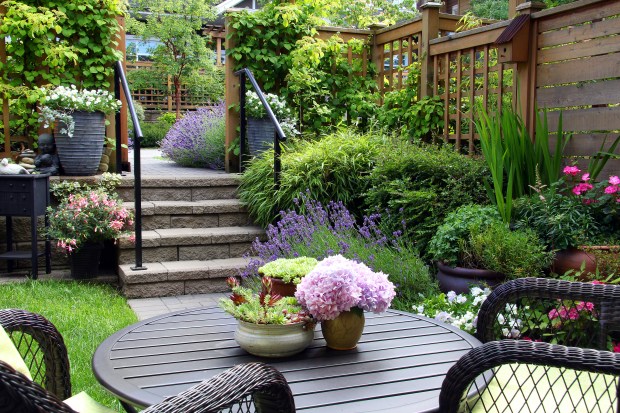
Garden design expert Fiona Jenkins from MyJobQuote.co.uk has created a guide on how to make your small garden look larger.
Add shelves – for additional storage and place to hold more plants.
Use foldaway furniture – to take up less space when not in use.
Add privacy – with fencing, trellis, brick walls or hedging.
Add a water feature – to make your garden seem like a natural retreat.
Go bright – when choosing plants, opt for bold colours to make the space pop.
Use large planters – to get more plants in less space.
Plant vertically – add plants upwards to make your garden seem fuller, and therefore, bigger.
Use blue flowers at the edges – blue flowers and plants recede into the distance and make the garden appear bigger.
Grow tall plants – it’s better to think big when it comes to a small garden.
Keep clutter a minimum – as it can give the illusion of less space than there actually is.
Lastly, there are some other illusions you can create with light and space, such as placing a mirror on a wall or fence to “visually double” the space.
Consider planting pale coloured flowers and plants such as white petunias, pale pink geraniums, or daisies to reflect light and make the space look bigger.
Chinese state media says the mission aims ‘to shed light on the formation and evolution of asteroids’ and the Earth.
China has successfully launched a spacecraft as part of its first-ever mission to retrieve pristine asteroid samples, in what researchers have described as a “significant step” in Beijing’s ambitions for interplanetary exploration.
China’s Long March 3B rocket lifted off at about 1.31am local time (18:30 GMT) on Thursday from the Xichang Satellite Launch Centre in southwest China’s Sichuan province. It was carrying the Tianwen-2 spacecraft, a robotic probe that could make China the third nation to fetch pristine asteroid rocks.
Announcing the launch, Chinese state-run news outlets said the “spacecraft unfolded its solar panels smoothly”, and that the China National Space Administration (CNSA) had “declared the launch a success”.
Over the next year, Tianwen-2 will approach a small near-Earth asteroid some 10 million miles (16 million km) away, named “469219 Kamoʻoalewa”, also known as 2016HO3.
The spacecraft is scheduled to arrive at the asteroid, which researchers believe is potentially a fragment of the Moon, in July 2026. It will then shoot the capsule with rock samples back to Earth for a landing in November 2027.
If successful, China would become only the third country to carry out such a mission after Japan first fetched samples from a small asteroid in 2010, followed by the United States in 2020.
The People’s Daily state-run newspaper described the mission’s purpose as an “endeavour to shed light on the formation and evolution of asteroids and the early solar system”.
The newspaper quoted Shan Zhongde, the head of the CNSA, as saying that the mission represented a “significant step in China’s new journey of interplanetary exploration”. He added that the mission was expected to yield “groundbreaking discoveries and expanding humanity’s knowledge of the cosmos”.
The mission has multiple goals over the “decade-long expedition”, according to Chinese state media, including “collecting samples from near-Earth asteroid 2016HO3” and “exploring the main-belt comet 311P”.
It will also aim to measure the “physical parameters of the two celestial targets”, including their “orbital dynamics, rotation, size, shape and thermal properties”.
The samples will be used to determine the “physical properties, chemical and mineral composition and structural characteristics” of asteroids, according to researchers working on the project.
As a quasi-satellite of Earth that has orbited the Sun in a synchronised path with the Earth for nearly a century, 2016HO3 has a diameter of between 120 feet (40 metres) and 300 feet (100 metres).
China has swiftly expanded its space programmes and embarked on several landmark missions in recent years, including landing robots on the far side of the Moon and collecting humankind’s first-ever samples from the area in June last year.
China is also running its own Tiangong space station in orbit – the only operational space station other than the International Space Station (ISS) – after the US barred it from participating in the ISS.
In April, three crew members landed back in the country’s north after spending six months on board Tiangong in what was the longest-ever mission in space by Chinese astronauts.
Beijing has also invested heavily in planned crewed missions to the Moon that would see Chinese astronauts on the lunar surface by 2030.
The US has also stated its aim to put astronauts back on the Moon for the first time since 1972, with NASA planning to launch its Artemis 3 mission in 2026 at the earliest.
SpaceX's giant Starship rocket crashed into the Indian Ocean after controllers lost contact with the spacecraft.
Source link
DEVELOPING STORYDEVELOPING STORY,
The ninth launch of Elon Musk’s futuristic SpaceX Starship comes after two previous space rockets blew up.
Billionaire Elon Musk’s commercial space flight company, SpaceX, lost control of its ninth Starship test flight 30 minutes after the uncrewed rocket vehicle was launched into space from Texas, the Reuters news agency reports.
The Starship then re-entered the atmosphere earlier than planned on Wednesday after an onboard leak triggered uncontrollable spinning in space, according to Reuters.
The test flight flew beyond the point of past failures, before losing control, Reuters added.
In a post on social media, SpaceX said the Starship experienced a “rapid unscheduled disassembly”.
“With a test like this, success comes from what we learn, and today’s test will help us improve Starship’s reliability as SpaceX seeks to make life multiplanetary,” the company added.
Musk has spent billions of dollars on Starship’s development. The South African-born billionaire claims the initiative is part of his commercial space flight company’s plan to colonise the planet Mars.
The latest test launch comes after a SpaceX Starship exploded shortly after takeoff on March 6.
The US Federal Aviation Administration (FAA) diverted several flights and briefly halted departures at four Florida airports, including Miami International Airport, as debris from that failed flight fell in the area.
IF you’re prepping your outdoor area for the relaxing summer ahead, a budget buy can level it up.
Lidl shoppers can elevate their garden or balcony’s privacy with this simple addition.
Whether you’re lying back and soaking up the sun or enjoying a meal al fresco, you don’t want to feel as though you’re on display to everyone in your neighbourhood.
If your outdoor area is a little too exposed for your liking, there’s no need to write it off.
You can now shield yourself from nosy neighbours with this colourful item.
As well as shielding you from prying eyes, this Lidl buy can also help to brighten up your garden.
Shoppers can pick up a Large Hanging Planter for just £6.99 from the middle aisle.
Customers can “choose from a wide range of colours to brighten up their outdoor space”.
According to the experts at Monrovia, staggering your hanging planters at different levels can help to create a natural separation from the outside world.
And it does so without adding an unsightly privacy fence or screen to your space.
“It creates the sense of separation without shouting ‘keep out,'” they explained.
But the gardening pros highlighted the importance of taking care of your planters.
They recommended watering your natural barrier regularly, especially in the hot weather.
Or you can opt for a more classic privacy product to shield your garden from public view.
Amazon also has a £14 privacy buy that is described as “perfect” for summer.
Another privacy fence is also available from Amazon, for just £5.
B&Q has an affordable privacy fence currently on sale, and you can put it up yourself.
CREATING privacy in your garden can be achieved in a number of ways depending on your budget, and the size of your space. Here are some effective ways to enhance privacy in your garden:
1. Fencing
2. Hedges and Plants
3. Outdoor Curtains
4. Sound Barriers
And a £10 B&M product adds inches to your fence, elevating your garden’s privacy.
You can also add a stylish touch to your privacy fence with another B&M buy.
A £3 buy from B&M is can also help to add privacy to your garden this summer.
And its not just fences that can help give you privacy in your garden, one B&M item can help shield you from nosy neighbours and the sun.
Meanwhile, a Home Bargains buy is said to add a touch of glamour to your garden.
Another item from the bargain retailer is perfect for attracting birds to your space.
US president says system will shield country from missile threats, including from space.
US President Donald Trump announces his latest defence plan: The Golden Dome.
Estimated at a cost of $175bn, it is designed to shoot down advanced missiles headed towards the United States.
Using both ground and space to detect incoming projectiles, it will far surpass a similar system used in Israel known as the Iron Dome.
But critics say it could prove ineffective and upset the balance of world power.
So, might the scheme lead to the militarisation of space and threaten the global order?
And could there be other motives behind Trump’s announcement?
Presenter:
Elizabeth Puranam
Guests:
Michael O’Hanlon, Senior fellow and director of research in foreign policy at the Brookings Institution
Youngshik Bong, Research fellow at the Yonsei University Institute for North Korean Studies
Marina Miron, Post-doctoral researcher at the war studies department at King’s College London
Teahouses built for spending extended time in, open until the wee hours of the night, are popping up all over the city. Some are elusive, hidden in plain sight or only accessible via a mysterious membership. Others have gone viral on TikTok and have cover charges and waitlists to attend. Some reference East Asian tea ceremony culture, others lean California cool and bohemian.
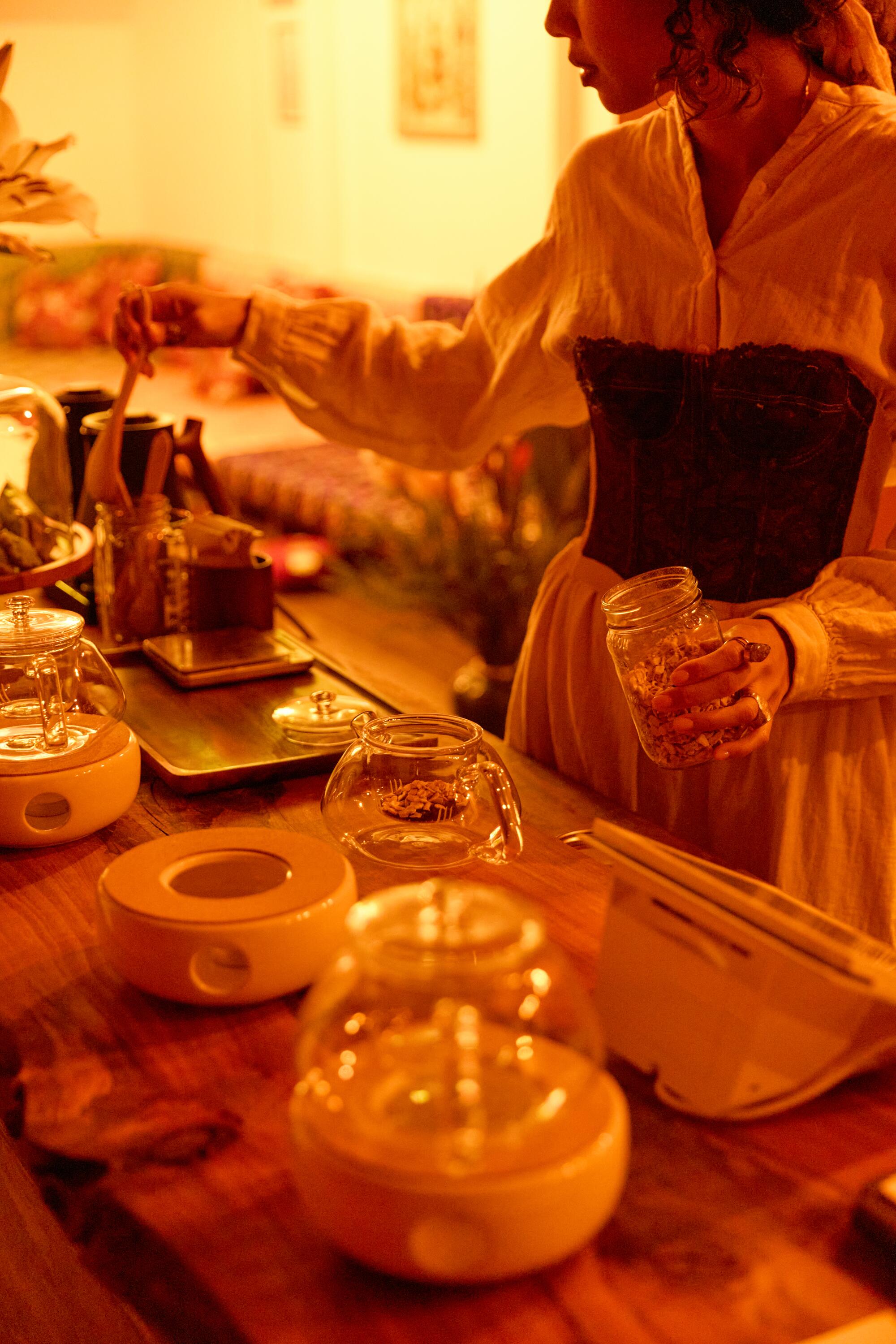
Jai Tea Loft owner Salanya Angel Inm prepares tea at her recently opened social gathering space in Koreatown.
(Dante Velasquez Jr. / For The Times)
Why the surge in places to drink tea? It might be because young people are consuming less alcohol (a 2023 study from Gallup found the number of people under 35 who drink has dropped 10% over the last two decades). Or maybe it’s due to the fact that the city has lost a sizable chunk of restaurants open past 10 p.m. — LAist reports nearly 100 since 2019 — leaving fewer places to sit and chat that aren’t bars or clubs. At the same time, activities centered on wellness and reflection, like gratitude groups, journaling or even reading silently in public, are being embraced by people of all ages looking for third spaces and activities outside of the standard dinner-and-a-movie.
Salanya Angel Inm was inspired to open Jai in Koreatown after years of feeling that Los Angeles lacked late-night spaces not oriented around alcohol. She wanted to create an alternative for her community of creatives, a place they could spend long hours loosening up outside of a bar environment. Lydia Lin, co-founder of Steep in Chinatown, which does serve alcohol along with plenty of tea, wanted a place that was open late but was peaceful enough that she could hear her friends while having a conversation.
Enter the rise of the teahouse. Despite their design and menu differences — some have a dozen herbal blends, others opt for dealer’s choice with a rotating set of three bespoke infusions; some are places to debut a trendy outfit, a few ask visitors to remove their shoes — they each come from a desire to challenge a typical consumer experience. These are spaces meant for lingering long after tea has been purchased, or even finished.
Below are four teahouses in different neighborhoods of Los Angeles.

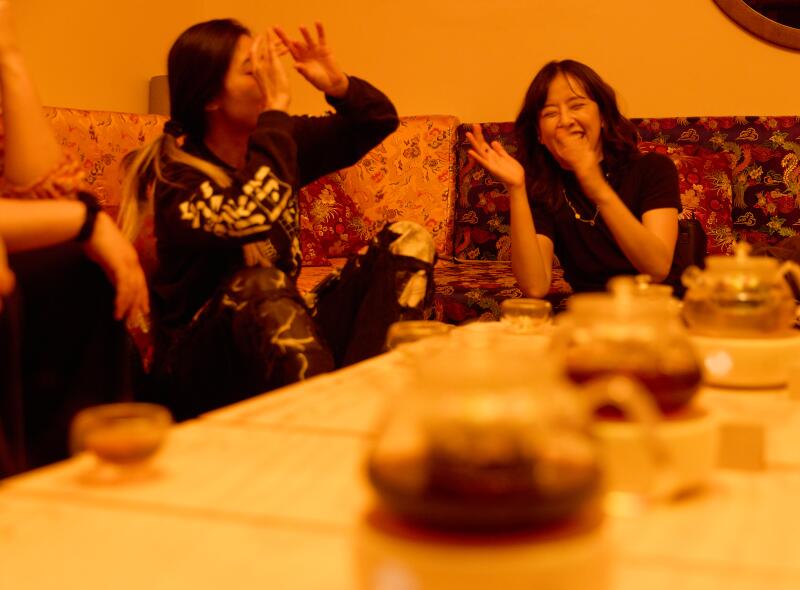
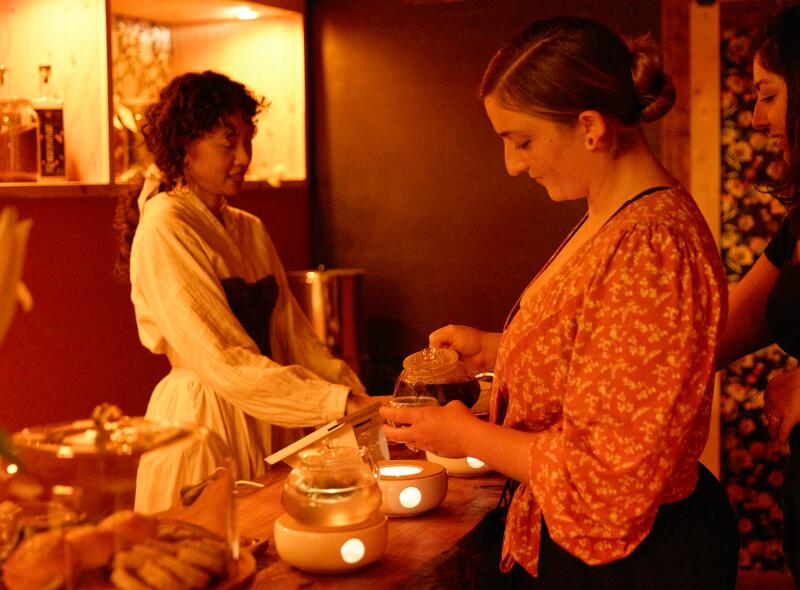
Scenes from a Saturday night in May at Jai Tea Loft. (Dante Velasquez Jr. / For The Times)
Located above Thai Angel, known for its DJ sets and late-night noodles, newly minted teahouse Jai offers a quieter, more intimate space to spend weekend nights. The spot is owned and operated by Thai Chinese American model and breathwork and reiki practitioner Salanya Angel Inm, who co-owns Thai Angel with her mom and brother. She began tinkering with the idea of opening a teahouse in May 2022. In January 2024, construction began, with a soft opening following in March 2025.
Jai is housed in a one-room attic on top of Thai Angel. It’s cozy, with space for two dozen people at most. The room glows in yellow-orange light from a neon art piece fixed to the ceiling and is lined with brightly colored custom floor cushions made of fabric from Thailand. On a Saturday night in March, seven guests removed their shoes and sat for a storytelling event, ticketed at $10. This was the second installment of the event; Inm had selected the theme “Lucky to be alive.” Some guests recited poetry, while others freestyled between sips of tea. The group exchanged stories and lounged until 3 a.m.

Guests socialize on a Saturday night at Jai Tea Loft in Koreatown.
(Dante Velasquez Jr. / For The Times)
Jordan Collins bought a ticket for storytelling at Jai after hearing about it on Inm’s social media. Upon arrival, he ordered a herbal elixir featuring Asian botanicals from the brand Melati. It’s one of three premade nonalcoholic tonics (the other two are “Awake” and “Calm” by California-based brand Dromme) that Jai serves room temperature for $9. A fan of art shows and experimental music performances, Collins described himself as always on the lookout for new community spaces. “I think that was the first time I pulled up to anything completely solo with no expectations, with the full intention to yap for however long to a room with complete strangers,” he said, likening his experience to a night spent chatting with friends into the morning.
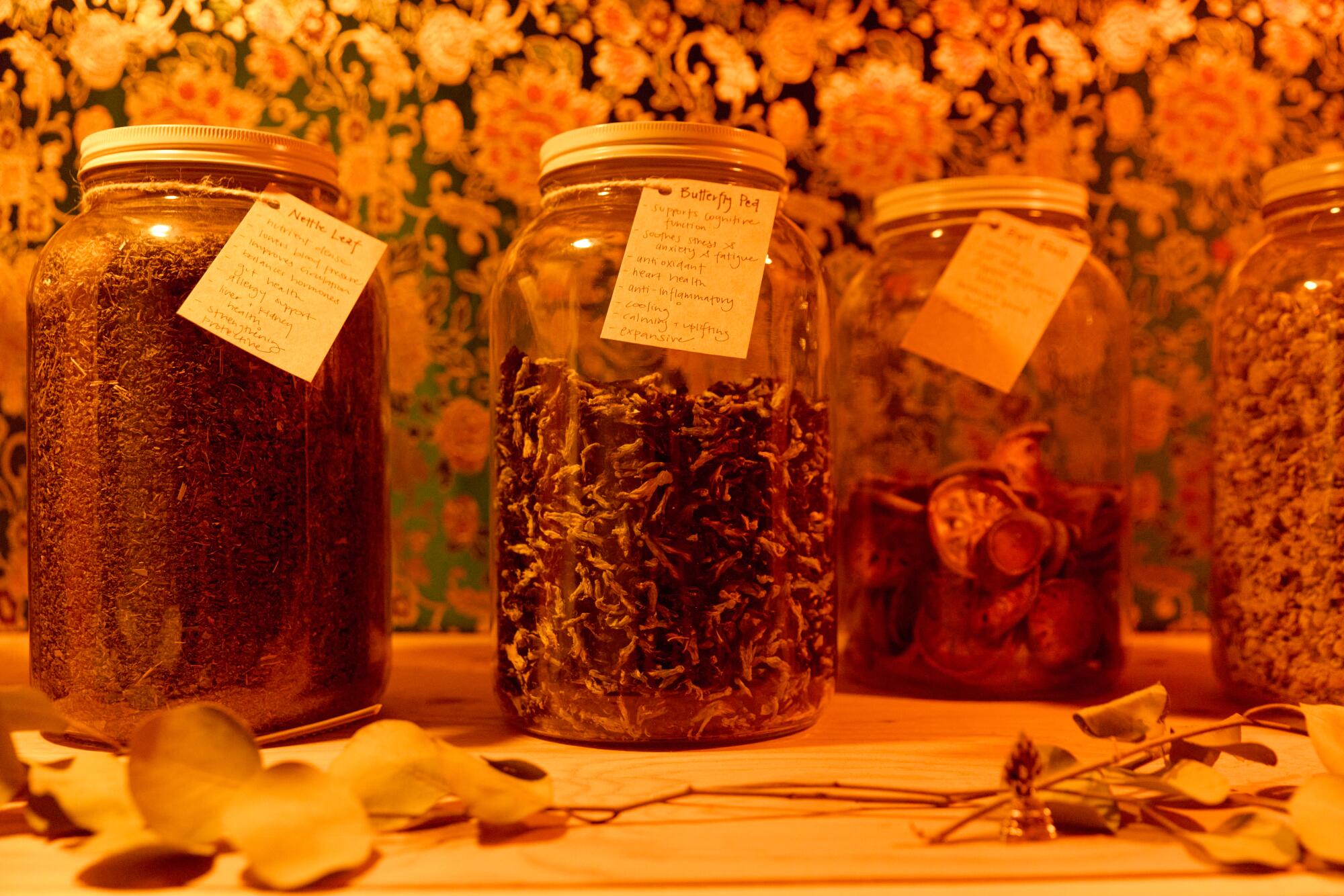
The tea selection at Jai Tea Loft.
(Dante Velasquez Jr. / For The Times)
The current menu at Jai consists of hot tea, sold by the glass or pot, along with the herbal elixirs — one invigorating, one calming and one berry. Tea drinkers can choose between more than a dozen herbs, from butterfly pea to white chrysanthemum, to create a custom blend prepared by Inm, starting at $15 per 25-ounce pot or $6 for a single serving. Behind the tea bar, she offers customers guidance based on their mood and needs.
She may expand the menu going forward but plans to keep costs low. “I really don’t like the idea that people can only access things that are good for them if they have a large amount of money to invest in themselves. I want people to feel like, ‘Yeah, I can swing that for this experience’ and it not be this obstacle,” said Inm.
Koreatown
149 N. Western Ave., Los Angeles, CA (upstairs)
Soft opening, see Instagram for hours
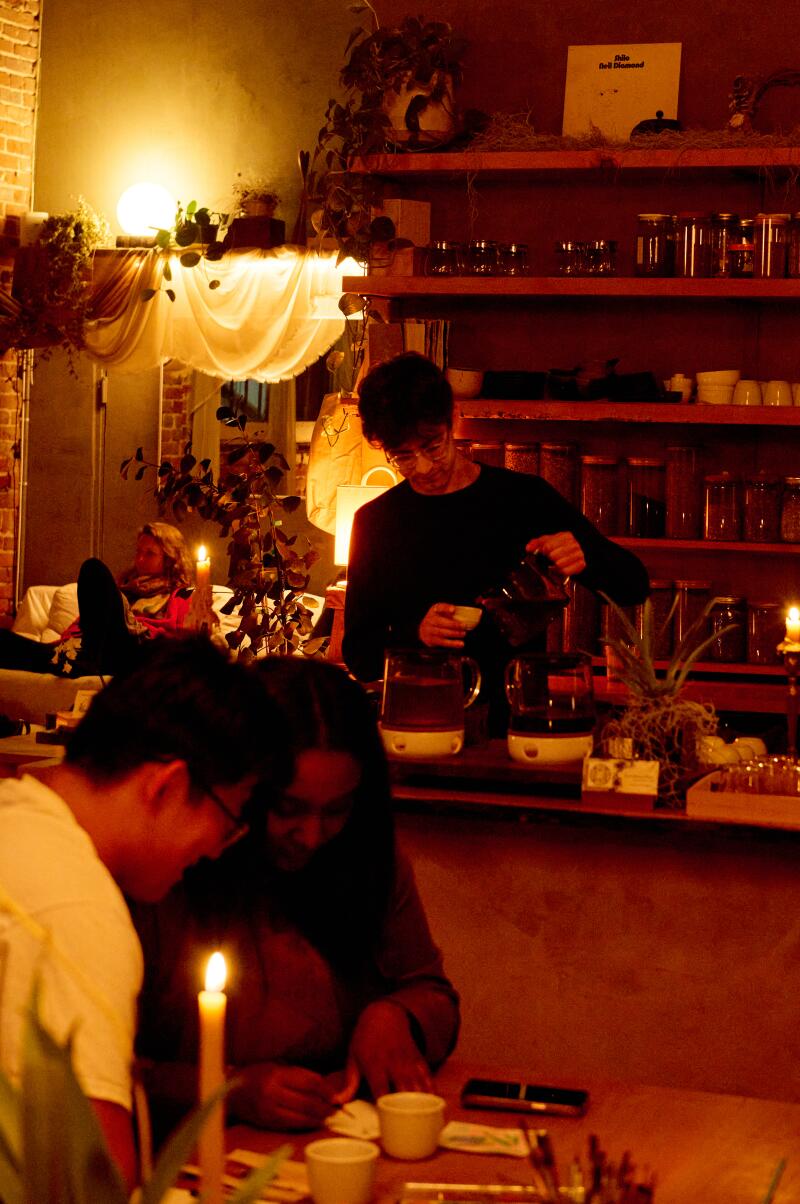
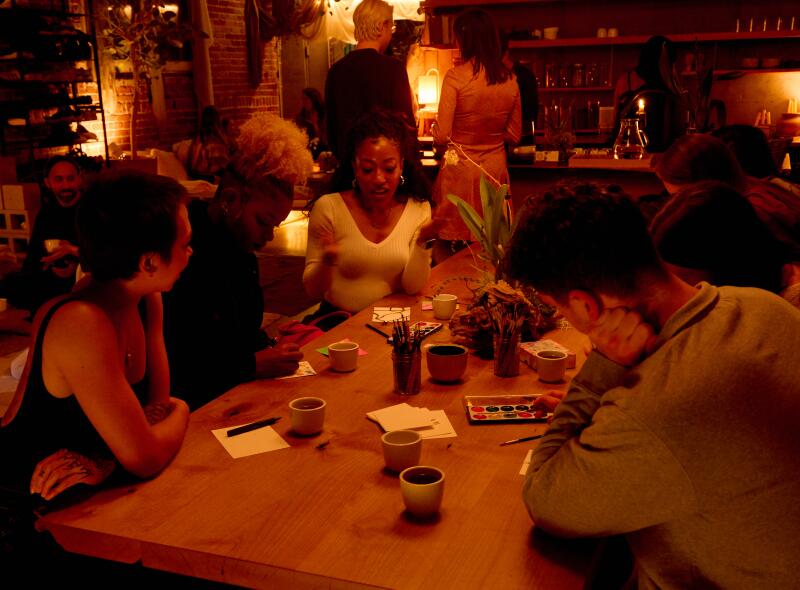
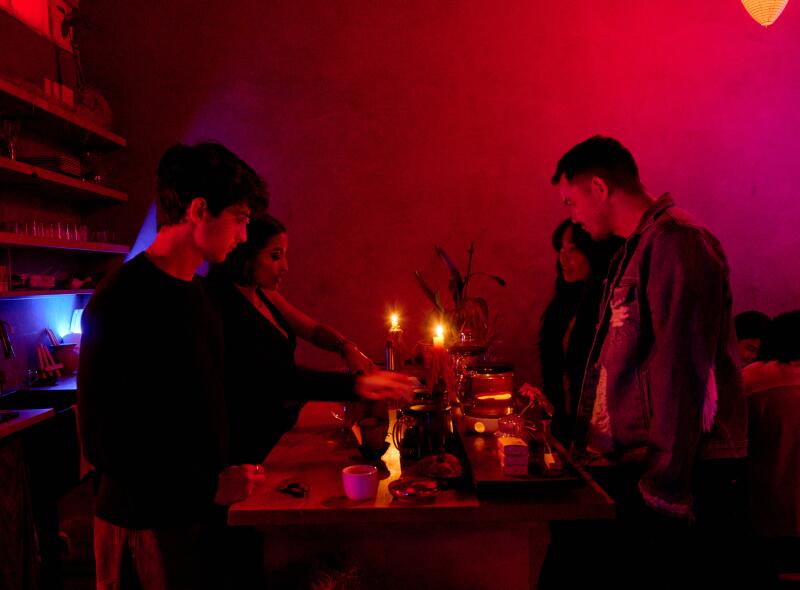
Patrons at Tea at Shiloh on a recent Saturday. (Yasara Gunawardena / For The Times)
Only 45 customers can enter Tea at Shiloh per evening, and those hoping to visit should plan ahead: Reservations, which are required, can be made through the website, and Tea at Shiloh fully books nearly every night.
As each attendee enters and takes off their shoes and adds them to the disorganized pile near the front of the door, a host asks them their intention for the evening. Patrons of the Arts District teahouse know what they’re getting into and answer the question with ease. The space attracts a metaphysically minded, wellness-oriented community. Some are there to journal, others to spend time with old friends. A few want to get out of their comfort zone; they come on dates, join with friends and arrive alone.

Guests socialize at Tea at Shiloh: A Teahouse.
(Yasara Gunawardena / For The Times)
The concept for Tea at Shiloh came to owner Shiloh Enoki (who goes by the mononym Shiloh) in 2019. Shiloh, who was born in Utah and is of South American descent, found herself unfulfilled working for a record label in Hollywood. She underwent a personal transformation that led to her quitting her job and legally changing her name. After a visit to a teahouse in San Francisco that closed in the afternoon, she couldn’t stop thinking how nice the experience would have been at night. She found herself looking for late-night teahouses back home in Los Angeles on Google Maps. To her surprise, she couldn’t find any. “I couldn’t believe that something that was in my brain didn’t exist on Google. I was like, ‘It has to be somewhere. It has to be somewhere in L.A.’ I live in one of the biggest cities in the world and nothing … I became obsessed,” she said. Shiloh began exploring herbalism and hosting friends and strangers at her home for tea, then decided to create a business that would provide what she’d been searching for. She opened the space in 2022.
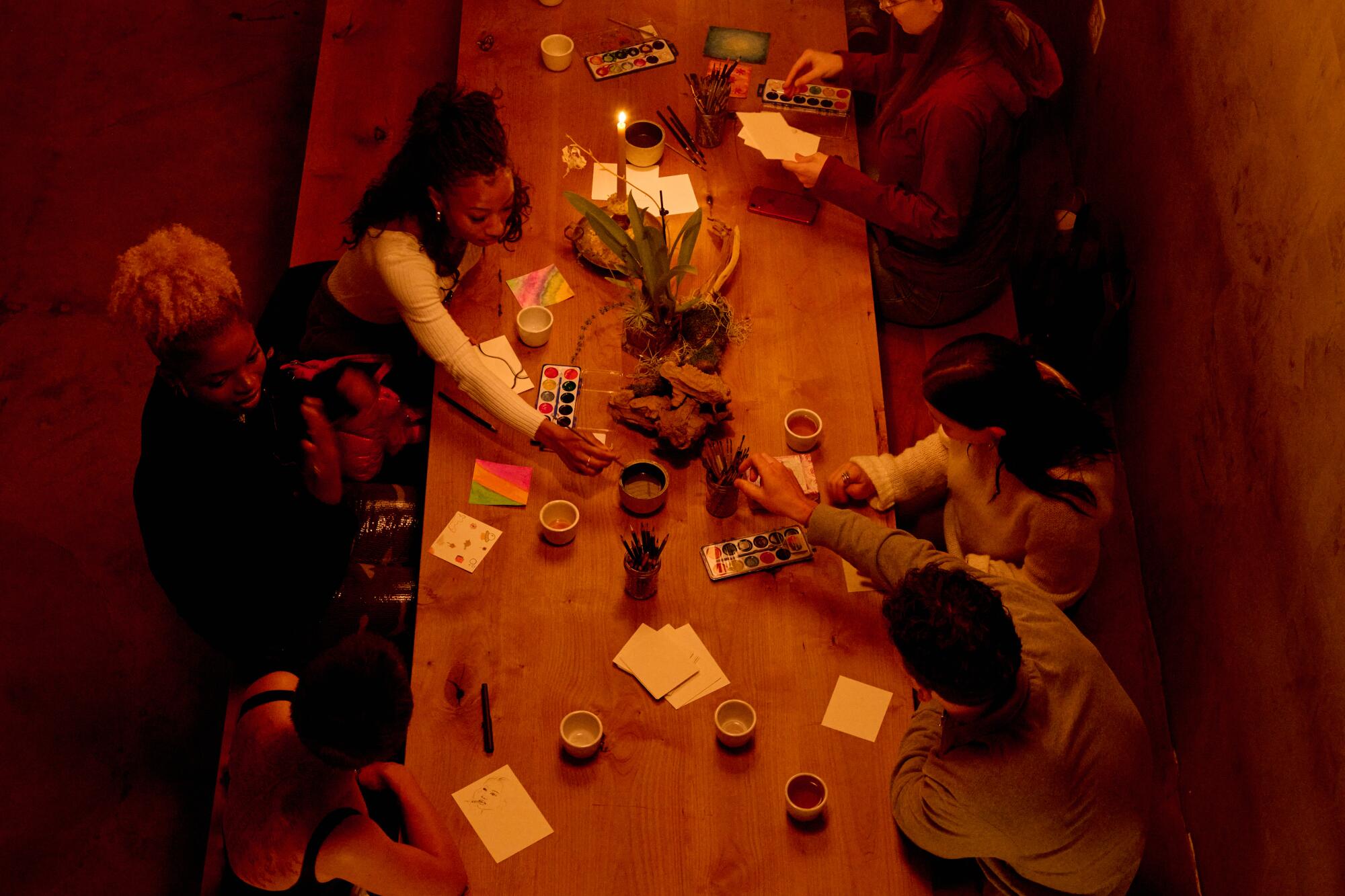
Faith Bakar, Alexsys Hornsby and Rachel Angelica painting at Tea at Shiloh.
(Yasara Gunawardena / For The Times)
Tea at Shiloh is inside an industrial loft. Brick walls and exposed piping contrast with wooden furniture, white couches and floor cushions and the warm glow of Noguchi lampshades. Surfaces are covered in books, tarot cards, clay and other art supplies to make use of. From 10 a.m. to 3 p.m., laptops are welcome. For the evening shift, which goes from 7 to 10 or 11 p.m., the lights go down and laptops are banned (with an exception for Monday’s piano lounge events). Both time slots require prepaid reservations, which, day or night, start at $37 and include unlimited access to the only thing on the menu, a rotating selection of three custom tea blends by Shiloh’s herbalists.
On some nights, there’s live music; others feature workshops in journaling, ceramics and other mind-body activities and performances. “It’s not a singular experience. There’s something for everyone,” Enoki said. After discovering the space on TikTok, Cooper Andrews took his partner to “cosmic jazz” (an eclectic mix of saxophone, keys, and abstract vocal looping) night at Shiloh to celebrate her birthday. He was looking for something other than just another fancy dinner, and for him, the $47-per-person cover charge was well worth it. “I see the fee as a cover charge. It’s like going to a museum,” he said.
Arts District
2035 Bay St., Los Angeles, CA 90021
Reservation only

Steep LA in Chinatown.
(Solomon O. Smith / For The Times)
Friends Samuel Wang and Lydia Lin come from cultures that take tea seriously. Wang, an industrial designer, is Taiwanese, while Lin, a marketing MBA working in the legal field, is Cantonese. In 2019, they separately went on trips to Asia to visit their families and discovered how modernized traditional teahouses had become. “[In China] people our age were going to teahouses instead of bars or clubs. It was somewhere that wasn’t home to just hang out and be able to have a conversation,” said Lin. “Why didn’t this exist in L.A.?” the friends asked themselves.
Within six months, thanks to the help of their Chinatown community, Lin and Wang — who didn’t quit their day jobs — opened Steep in the fall of 2019. Opening night was the Chinese Mid-Autumn Festival, Lin remembers, an important and auspicious day.
The minimalist tea lounge hides in the back of a plaza in Chinatown. There’s space inside for a few dozen guests and a handful of outdoor tables for when weather permits. Inside, there’s a beautiful marble bar, wood tables, a cozy couch and long tables with tea leaves in jars to smell and discover.
By day, Steep serves 10 rotating teas, all sourced from China and Taiwan. Customers can order a glass of cold-brewed tea or fresh-brewed tea, but Lin encourages a tea ceremony, which comes with a pot and up to four cups. Baristas walk guests through the steps of brewing and pouring the tea, providing a timer for the perfect steep.
By night, Steep is the only business open in its plaza. Inside, soothing R&B plays. And, unlike the other teahouses that have popped up recently in Los Angeles, Steep serves alcohol. After 5 p.m., the space shifts from cozy teahouse to experimental mixology bar, serving boozy concoctions that all feature tea as an ingredient. Take the Yuanyang Martini, an espresso martini with black sesame and black tea or Red Robe, featuring cognac, bourbon, oolong tea and white miso. At 9 p.m. on a Thursday in March, nearly every seat was filled. Half of the guests enjoyed cocktails, while the rest shared pots of tea.
Chinatown
970 N. Broadway #112, Los Angeles, CA 90012
11 a.m.-11 p.m. daily; closed Tuesday
There’s no information about NEHIMA online except for an email address. The invite-only, membership-based Japanese teahouse opened in Los Feliz in 2022. It’s more exclusive than any Soho House, San Vicente Bungalows or Bird Streets Club. So much so that its founders, Miho Ikeda and Richard Brewer, also co-owners of New High Mart, an equally exclusive Japanese home goods boutique, agreed only to speak about their latest venture via email.
“Serving tea to-go is to miss the entire point of tea. Tea is time. An excuse to enjoy a moment, a pause, a rest — either with oneself or the company of others,” said Brewer. The space has a strict no-technology policy. Even smartwatches are required to be checked in lockers along with phones.
At NEHIMA, all tea is served made-to-order, tableside, in pieces from the owner’s collection of Japanese ceramics. There are no matcha, lattes or novelty drinks on the menu, only loose-leaf tea sourced from Japan. NEHIMA is careful to distinguish that while the space and experience recall Japanese tradition, the club does not offer an official tea ceremony. “That term is thrown around too easily these days and should be reserved for describing the very specific event, ‘Cha-No-Yu,’” said Brewer.
The founders said the average visit is between three and six hours. Where most members clubs try to offer a luxurious experience for the wealthy through elevated design, upscale food and posh clientele, taking time to relax and enjoy a pot of tea is what NEHIMA sees as the ultimate luxury. “In this busy demanding world, time is the new flex, and real wealth is taking time to stare into a bowl of tea,” said Brewer.
Los Feliz
4650 Kingswell Ave., Los Angeles, CA 90027
Members only
Washington, DC – United States President Donald Trump and Secretary of Defense Pete Hegseth have laid out their clearest plan yet for the “Golden Dome” missile defence programme, which would include putting weapons in space for the first time.
Speaking from the White House on Tuesday, Trump said he had “officially selected an architecture” for the system, designed to take down “hypersonic missiles, ballistic missiles and advanced cruise missiles”.
“I promised the American people that I would build a cutting-edge missile defence shield to protect our homeland from the threat of foreign missile attack,” Trump told reporters in the Oval Office.
The Golden Dome system, he added, would include “space-based sensors and interceptors”.
“ Once fully constructed, the Golden Dome will be capable of intercepting missiles even if they are launched from other sides of the world and even if they’re launched from space,” Trump continued. “We will have the best system ever built.”
The announcement comes just less than four months after Trump signed an executive order kicking off the programme’s development. General Michael Guetlein – who currently serves as the vice chief of space operations at Space Force, a branch of the US military – is slated to manage the programme.
Speaking at the event, Hegseth hailed the plan as a “game changer” and a “generational investment in security of America and Americans”.

The White House did not immediately release further details about the missile defence system, and the Pentagon is reportedly still working out its capabilities and requirements.
The Congressional Budget Office estimated earlier this month that the space-based components of the Golden Dome alone could cost as much as $542bn over the next 20 years.
It noted that a high number of sensors and interceptors would be needed for a space-based system to be effective, particularly as foreign militaries like North Korea’s grow more sophisticated.
But on Tuesday, Trump outlined a much lower price tag and timeline.
“It should be fully operational before the end of my term. So, we’ll have it done in about three years,” Trump said.
He estimated the total cost to add up to about $175bn, adding that he planned to use existing defence capabilities to build the system.
But the funding for the programme has so far not been secured. At Tuesday’s news conference, Trump confirmed that he was seeking $25bn for the system in a tax cut bill currently moving through Congress, although that sum could be cut amid ongoing negotiations.
There is likely to be some variation in the total cost of the project. The Associated Press news agency, for example, cited an unnamed government official as saying that Trump had been given three versions of the plan, described as “medium”, “high” and “extra high”.
Those tiers corresponded to how many satellites, sensors and interceptors would be put in space as part of the programme. The news agency reported that Trump chose the “high” version, which has an initial cost ranging between $30bn and $100bn.
As he explained his plans for the Golden Dome on Tuesday, Trump cited several inspirations, including Israel’s “Iron Dome” missile defence system, which is funded in part by the US.
He also pointed to the work of a fellow Republican, the late President Ronald Reagan, who served in the White House during the Cold War in the 1980s.
As part of his Strategic Defense Initiative in 1983, Reagan had proposed a barrier to nuclear weapons that included space-based technology.
“ We will truly be completing the job that President Reagan started 40 years ago, forever ending the missile threat to the American homeland,” Trump said.
But questions have persisted over the viability of a space-based defence system, its price, and whether it could ignite a new arms race.
Democrats have also questioned the possible involvement of Elon Musk’s SpaceX, which is a frontrunner among the technology companies seeking to build key components of the system.
A group of 42 Democratic lawmakers have called for a probe into Musk’s role in the bidding process, pointing to his position as a special adviser to Trump and his substantial campaign donations to the president.
“If Mr. Musk were to exercise improper influence over the Golden Dome contract, it would be another example
of a disturbing pattern of Mr. Musk flouting conflict of interest rules,” the Democrats wrote in a letter, calling for the probe.
On Tuesday, Trump did not directly respond to a question about which companies would be involved in the Golden Dome. Instead, he highlighted that the system would boost industries in states like Alaska, Indiana, Florida and Georgia.
He added, “Canada has called us, and they want to be a part of it. So we’ll be talking to them.”
Attempt to place surveillance satellite into orbit fails after launch vehicle PSLV-C61 encountered a technical issue, ISRO chief says.
India’s space agency says it has failed to place the EOS-9 surveillance satellite into the intended orbit after its launch vehicle PSLV-C61 encountered a technical issue in a rare setback for the agency, known for its low-cost projects.
The EOS-09 Earth observation satellite took off on board the PSLV-C61 launch vehicle from the Satish Dhawan Space Centre in Sriharikota, located in the southern Indian state of Andhra Pradesh, on Sunday morning.
“During the third stage … there was a fall in the chamber pressure of the motor case, and the mission could not be accomplished,” said V Narayanan, chief of the Indian Space Research Organisation (ISRO).
“We are studying the entire performance, we shall come back at the earliest,” he said in a statement to local media.
#WATCH | Sriharikota, Andhra Pradesh | ISRO Chief V Narayanan says, “Today we attempted a launch of PSLV-C61 vehicle. The vehicle is a 4-stage vehicle. The first two stages performed as expected. During the 3rd stage, we are seeing observation…The mission could not be… pic.twitter.com/By7LZ8g0IZ
— ANI (@ANI) May 18, 2025
The world’s most populous nation has a comparatively low-budget aerospace programme that is rapidly closing in on the milestones set by global space powers.
Active in space research since the 1960s, India has launched satellites for itself and other countries, and successfully put one in orbit around Mars in 2014.
In August 2023, India became just the fourth nation to land an unmanned craft on the moon after Russia, the United States and China. Since then, ISRO’s ambitions have continued to grow. Its first attempt to land on the moon failed in 2019.
So far, ISRO has recorded three setbacks in PSLV missions, including Sunday’s. The first failure was in 1993.
On Sunday, Narayanan said ISRO would study the performance and provide details on what went wrong at a later stage.
According to local media reports, a Failure Analysis Committee will also be set up to investigate the space agency’s latest setback.

Liftoff for Starlink mission 15-5 was 9:43 a.m. EDT from Vandenburg Space Force base, lofting 26 more Starlink satellites into low-Earth orbit. Depicted is a Starlink launch from the Cape Canaveral Space Force Station, Florida on Wednesday. Photo by Joe Marino/UPI | License Photo
May 16 (UPI) — SpaceX Friday launched another routine Starlink satellite launch from California, the 20th this year.
Liftoff for Starlink mission 15-5 was 9:43 a.m. EDT from Vandenburg Space Force base, lofting 26 more Starlink satellites into low-Earth orbit.
The Falcon 9 first stage booster B1093 launched the satellites and then touched down in the Pacific Ocean a little more than eight minutes later on the droneship ‘Of Course I Still Love You.’
The launch was live streamed.
Friday’s launch brought the number of Starlink satellites in orbit to over 1,000.
It was the second flight for booster B1093. It was used 39 days ago in the Starlink 11-11 mission launched from Vandenburg.
SpaceX advised that residents of Santa Barbara, San Luis Obispo, and Ventura counties could possibly hear sonic booms from the launch.
WASHINGTON — The head of the U.S. Space Force is moving ahead with plans to pull talent from Air National Guard units to help build up the still new-military service — but several governors remain opposed and argue it tramples on their rights to retain control over their state units.
Overall, the plan would affect only 578 service members across six states and the Air National Guard headquarters and augment the Space Force without creating a separate Space Force National Guard — something the service has said would not be efficient because it would be so small.
“We are actively pursuing where do we want our part-time workforce? What type of work do they do?” the head of Space Force, Gen. Chance Saltzman, said Thursday at a Politico conference.
The transferred service members would be a part-time force like they are now, just serving under the Space Force instead of their state units.
But space missions are some of the most lucrative across the military and private sectors, and the states that lose space mission service member billets are potentially losing highly valuable part-time workforce members if they have to move away to transfer to the Space Force.
Last month, the National Governors Assn. said the transfers violate their right to retain control over their state units.
“We urge that any transfers cease immediately and that there be direct and open engagement with governors,” the association said in April. The group was not immediately available to comment on Space Force’s plan.
“There’s a lot of concern in the National Guard about these individuals who are highly skilled that want to be in the Guard being transferred out,” Oklahoma Republican Sen. Markwayne Mullin said at an Air Force manpower hearing this week.
Congress directed the transfers in its 2025 defense bill. But the contention between the states and the Space Force has meant the service hasn’t so far been able to approach individual members about transferring in.
According to the legislation, each National Guard will get the option to either stay with their units — and get retrained in another specialty — or join the Space Force. Those who do transfer would be allowed to remain in their home state to perform their mission for at least the next 10 years, according to the 2025 legislation.
The affected personnel include 33 from Alaska, 126 from California, 119 from Colorado, 75 from Florida, 130 from Hawaii, 69 from Ohio and 26 from Air National Guard headquarters
Copp writes for the Associated Press.
I created my first Instagram account in March 2015 when I was 13 years old. Back then, social media was just a space for me to share photos of my cats and keep an eye on whatever One Direction was up to. Fast forward 10 years, and social media is now a tool I use to keep in touch with family and follow along with politics – while still, of course, sharing photos of my cat.
I’ve always had quite a toxic relationship with social media. I’ve gone back and forth on the idea of deleting all of my accounts and never touching an app again, but I could never bring myself to do it. As someone who has moved cross country multiple times, I don’t want to lose contact with almost everyone I grew up with, and social media is an amazing tool to discover and connect with LGBTQIA+ communities that I wouldn’t have otherwise found. The truth is, I’d feel extremely lonely if it wasn’t for social media.
Though it’s important to me to keep up with current events, the whiplash of scrolling from a cute guinea pig video to a violent debate over basic human rights was starting to have a serious effect on my mental health. I was doom scrolling more than ever, to the point where I needed to put a one hour screen time limit on certain apps for my own sanity.
So, I decided to create myself a digital safe space, a place where I could access the positive, uplifting side of social media, while avoiding the content that was impacting my mental health.
I recently created a brand new account to share my artwork, but I made an effort to only follow other artists and regularly search for arty advice, tips and tricks. The algorithm must have caught on pretty quickly, because suddenly my explore page was entirely made up of artists and small business owners who were sharing their incredible artwork and uplifting each other. All of a sudden I was in a space that was wholeheartedly positive, creative and inspiring.
This wasn’t at all what I was used to on my personal account, which was rampant with politics and people arguing with each other. Of course, the concept of having a second Instagram account wasn’t something that was new to me – I’ve had an account specifically for sharing sunset photography, one for special effects makeup and various “aesthetic accounts” – but this was the first time I intentionally curated an algorithm. It just so happened to be an overwhelmingly positive community I chose to seek out.
The dining room ceiling, adorned with an unexpected burst of orange floral wallpaper, breathes new life into the 100-year-old house. Similarly, the living room’s coral, pink and green wallpaper, the den’s bold blue and yellow stripes, and the red pattern-filled speakeasy lounge are delightful surprises that keep you guessing what’s next.
Standing beneath a glittering tiered chandelier in her pink “cloffice,” designer Dani Dazey shares the essence of her colorful style: “From the wallpaper to the artwork, my home is a reflection of me right now,” she explains. “It’s a personal and hip twist on traditional design.”
Rather than embrace rustic farmhouse style or minimalist Midcentury Modern design as is often the case in Los Angeles, Dazey has taken the Highland Park home she shares with husband Phillip Butler and given it an over-the-top maximalist spin.
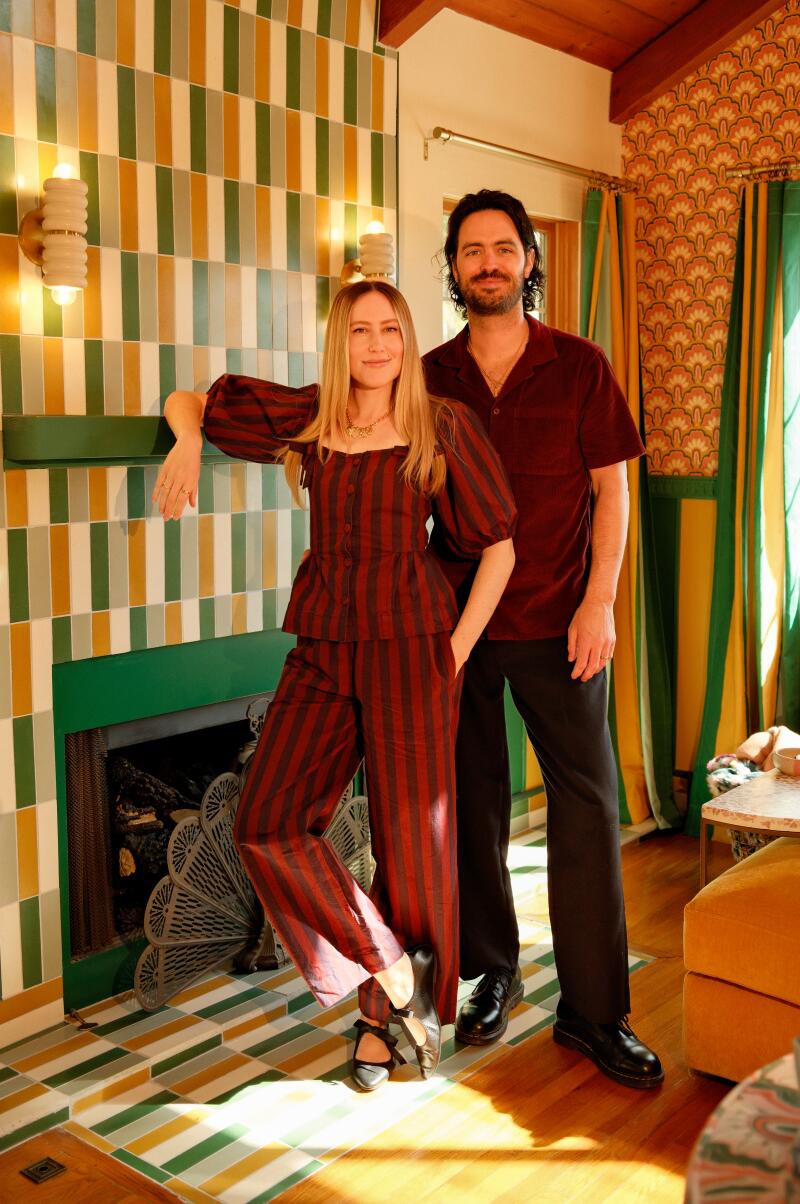

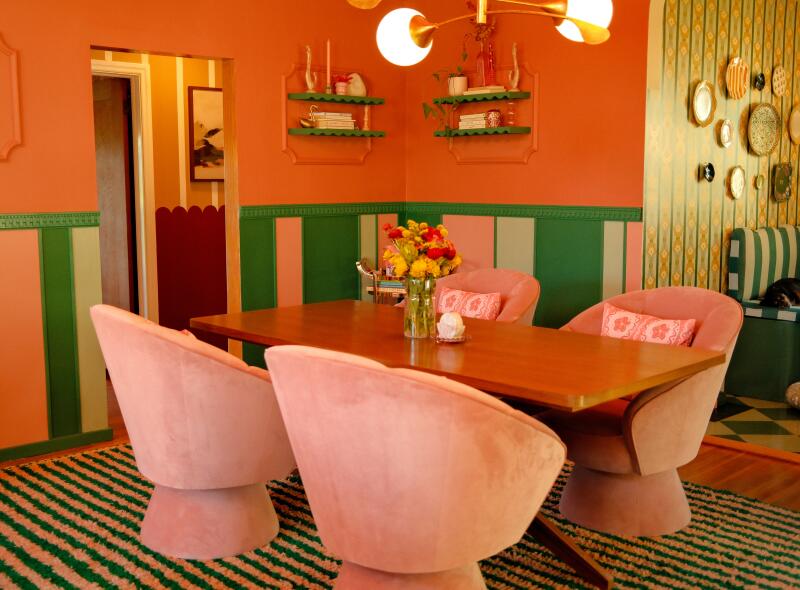
Dani Dazey and her husband Phillip Butler stand in the living room of their home, which connects to the adjacent dining room and alcove. Dazey designed the colorful furnishings, wallpaper, textiles and many of the artworks. “I am very pro printed furniture,” she said. “I’m a very big fan of matching my colors and having a tight color palette.”
Their home is proof, as Dazey outlines in her new book, “The Maximalist: Colorful Interiors for Bold Living,” out May 20, that our homes should make us happy by reflecting who we are. In Dazey’s case, that translates to bold color, lush textures and retro vibes.
“Throughout my career, my core message has been to empower people to be who they are and not be afraid to embrace the things they love,” said Dazey, 34.
“Our homes are where life unfolds. They should offer a narrative of who we are and what we like, and I doubt anyone’s story is a boring white box.”
— Dani Dazey in “The Maximalist”
From the outside, the couple’s home exudes a subtle charm. However, stepping through the front door unveils a captivating burst of vibrant color and Dazey’s signature flower prints, all surprisingly harmonious.
“I worked as an apparel graphic designer and I applied all that to interior design,” she said. “I know how to put all these things together and make them look nice.”
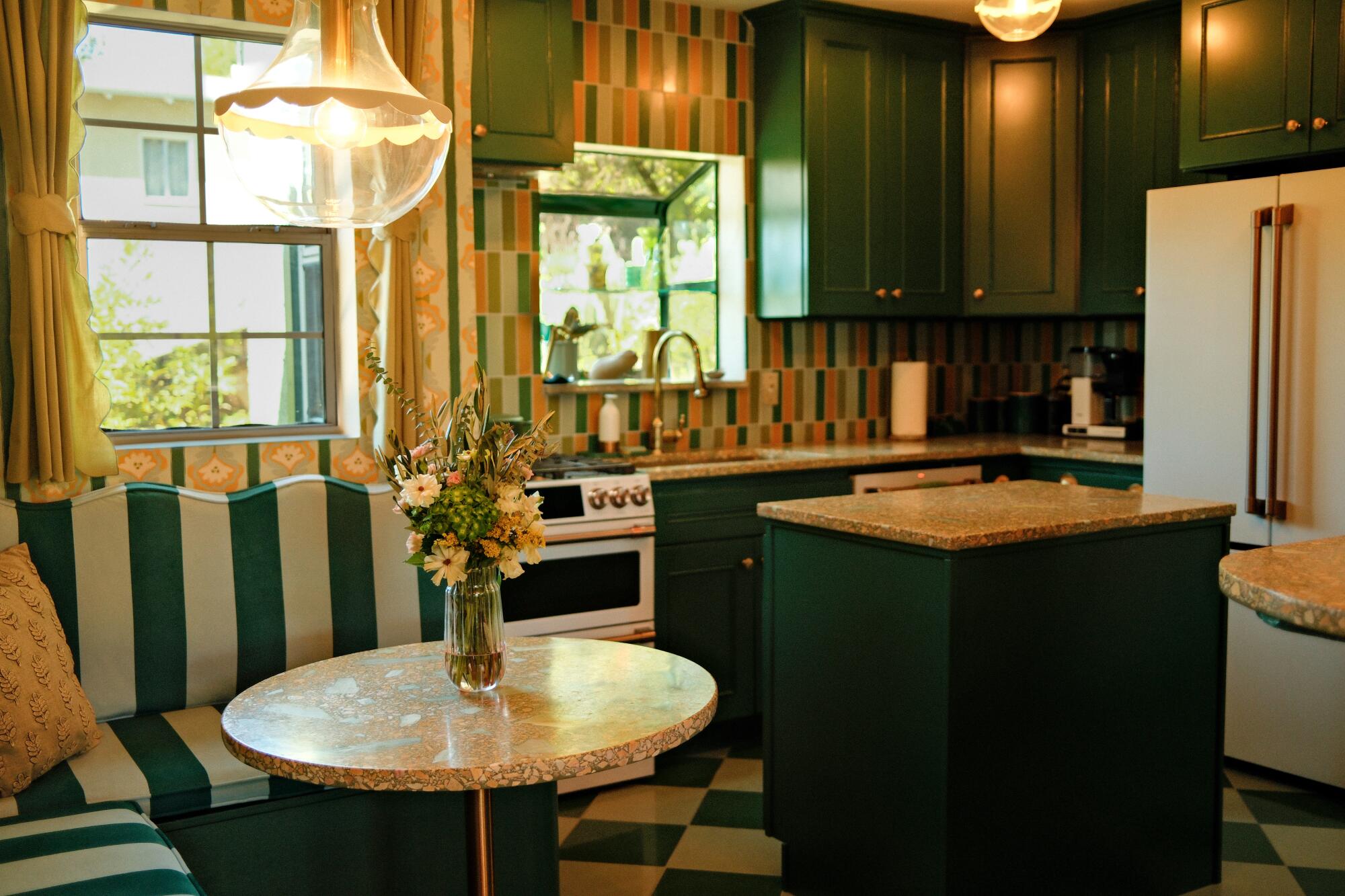
Dazey designed the kitchen to look like an old Italian villa.

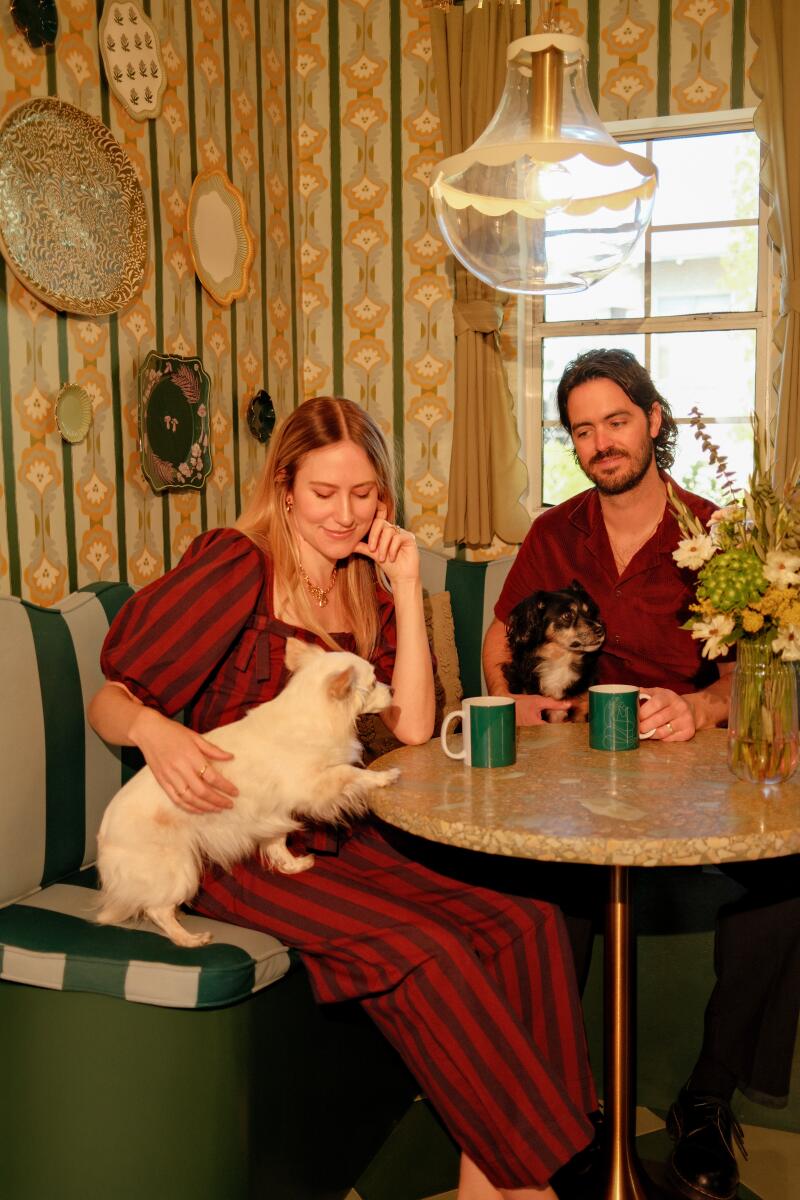
“Curtains help the rooms not feel too cluttered and crazy,” said Dazey. “I can make everything very cohesive. The fifth wall — the ceiling — it makes a big difference.”
The “fifth walls,” as Dazey calls the ceilings, are painted bright orange, red and turquoise blue. Floors are lined with vibrant green checkerboard patterns and wall-to-wall carpet. Likewise, the lawn in the back is decked out in checkerboard artificial turf. The speakeasy lounge, accessible through a hidden door sliding bookcase, is a ‘70s-inspired sanctuary with a modular sofa, curtains and wallpaper in the same floral pattern. Underneath the living room ceiling, Dazey has created a plant-filled ledge that cascades over the dining room, adding a touch of nature to the vibrant spaces.
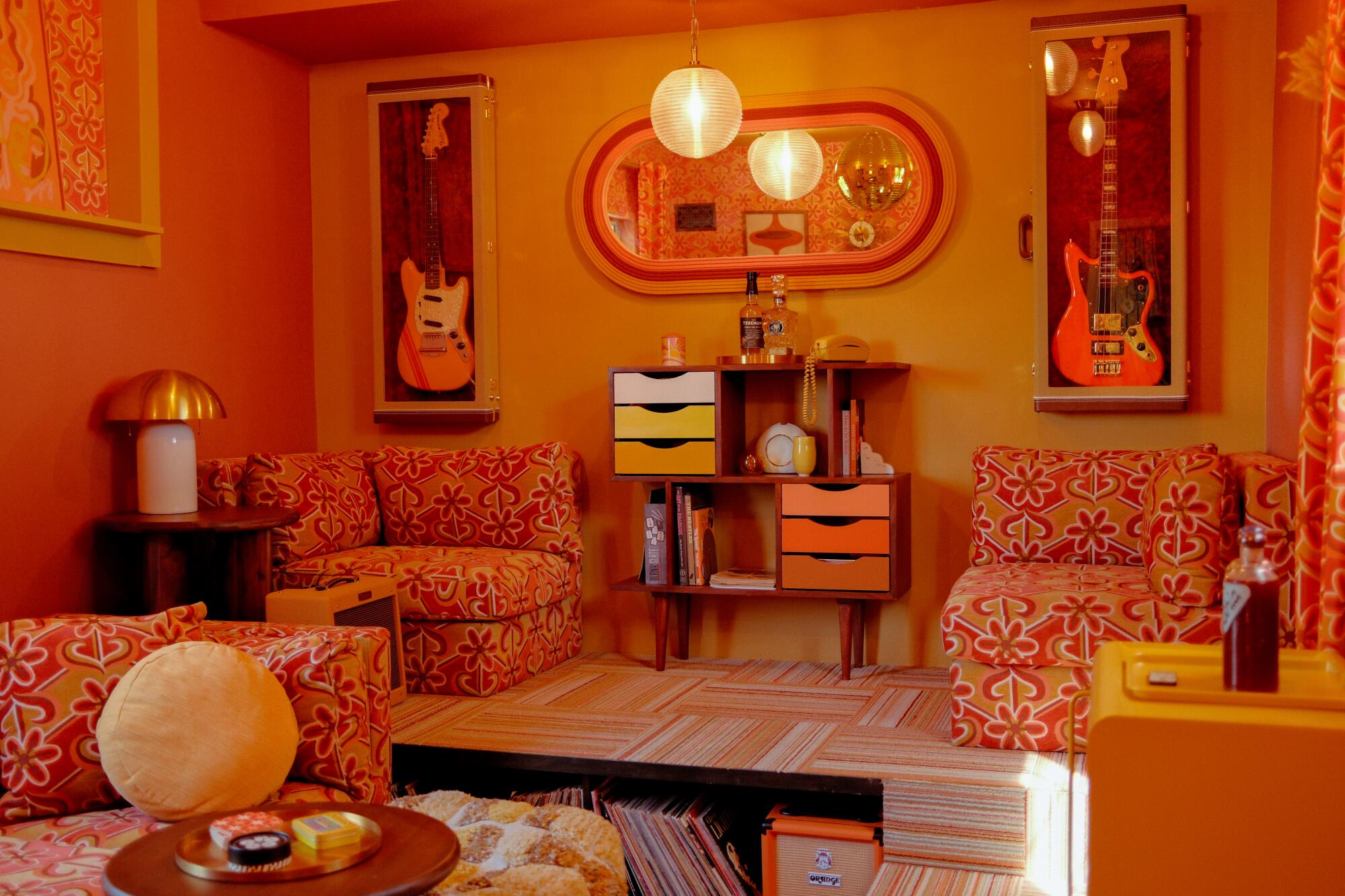
Dazey outfitted the chairs, modular sofa from Joybird, wallpaper and curtains in the same ‘70s-inspired pattern.
Everyone — including the couple’s two dogs, Franklin and Yuki, who luxuriate on a pink velvet daybed in the sun — is happy here.
“Living in a maximalist space brings me joy,” said Butler, who handles operations for Dazey’s interior design business and their Airbnb and Peerspace rentals. “Even just looking at the ceiling makes me happy.”
Like the Madonna Inn, where the couple recently hosted their wedding, their home is “fun and quirky and anything but traditional,” Dazey said. “As a creative person, you get burned out by doing the same thing over and over again.”
The couple discovered the 2,300-square-foot, two-story home on a 3-acre lot two years ago. Dazey said there wasn’t a lot of interest in the house, as it featured an unusual floor plan with a separate apartment on the first floor with its own entrance. “The house blew us away,” she said, “but the strange floor plan confused us.”
The house they purchased for $1.75 million was “turnkey,” and Dazey had fun adding skylights to the beamed ceilings in the living room and redoing the kitchen to feel like an old Italian villa. The couple worked quickly over six months so that Dazey could share her projects on social media. “Much of our work comes from social media so having a project to share was helpful. That’s a big part of our job — creating these spaces.”

Dazey transformed the gravel driveway into an outdoor living space with turf, a cowboy pool and chaise lounges.
Her efforts paid off. The entrepreneurial couple now rents their home, along with a pink California bungalow and a bungalow in Palm Springs, for celebrity photo shoots and music videos. (Janelle Monáe, Camille Cabello and James Marsden have all been featured in their rental homes.)
It’s a unique side hustle, and the couple’s success is impressive. “They are such fun, wacky rentals,” Dazey said. “Between our Palm Springs Airbnb and L.A. photo shoots, we made $30,000 last month — our biggest month ever.”
Added Butler: “People tell us their kids love our houses.”
The home’s unconventional layout allows the couple to reside in the adaptable space downstairs while renting out the top floor for photo shoots. Following the recent fires in Los Angeles, they were able to provide housing for families in need on a monthly basis. “It’s been rewarding to be able to help in this way,” Dazey shared.
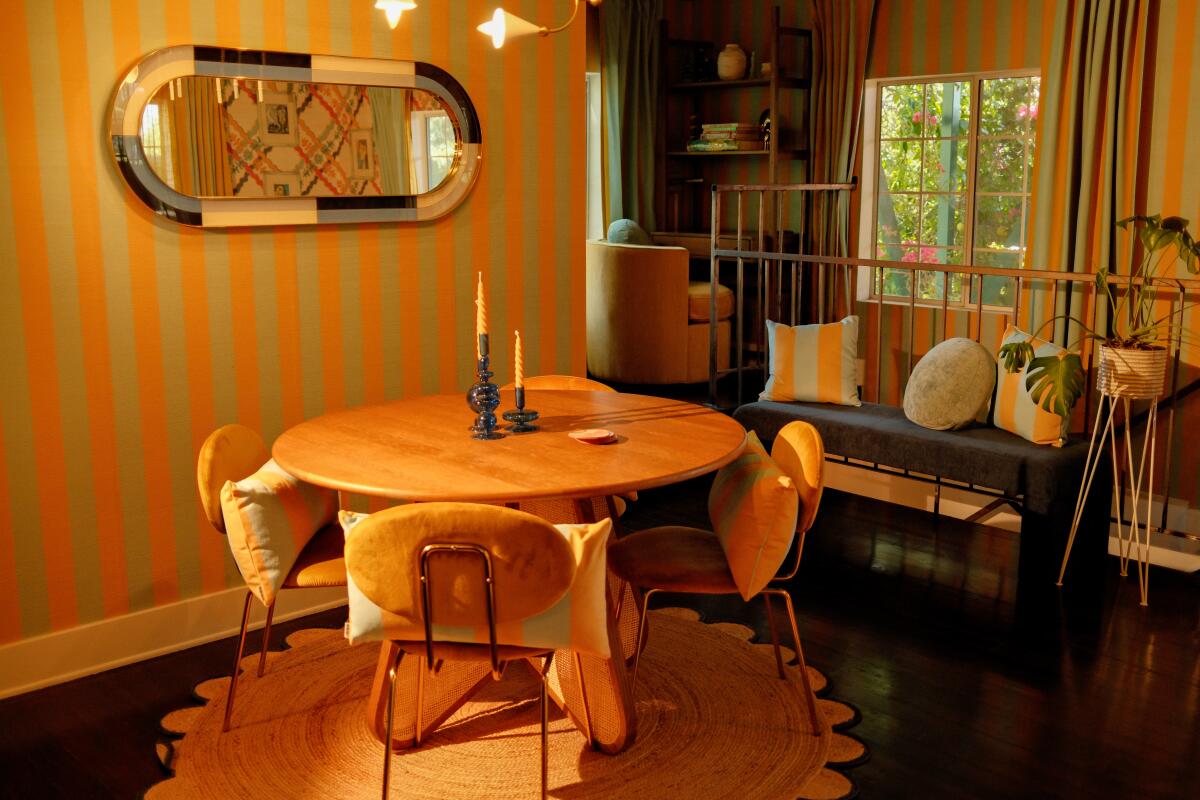

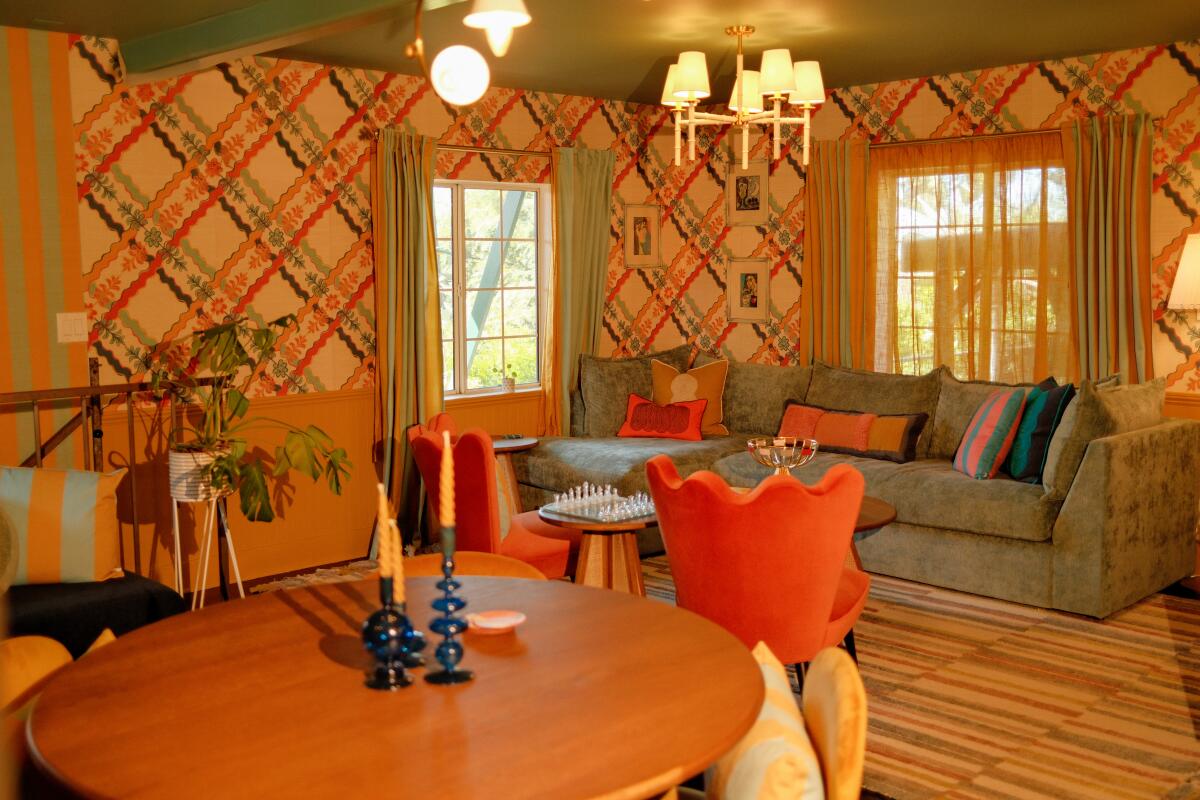
Dazey brightened the home’s first floor suite, which felt like a basement, with colorful textiles, wallpaper, stripes and FLOR tiles.
Dazey grew up in Lake Arrowhead in the San Bernardino Mountains. Her parents were creative, encouraging Dazey and her sister to be “colorful and engage in art and pursue” their passion. Not surprisingly, the family had a raspberry-colored kitchen. “My mom just painted the cabinets in her condo bright yellow,” Dazey said. “It’s wacky. I appreciate it.”
After studying fashion design, she made a name for herself in Los Angeles as a fashion designer for Dazey LA and, most recently, as an interior designer. She started her clothing line with $4,000. Over eight years it took off on social media and she eventually sold to stores including Anthropologie. “There were a few years where it nearly grossed a million dollars in revenue,” she said. “It helped me purchase the Palm Springs house.” Still, she is best known for her collaboration with drag performer and singer Trixie Mattel on the design of the Trixie Motel in Palm Springs.“Trixie’s aesthetic is similar to mine,” Dazey said with a laugh. “We both love bright colors and florals and retro design.”
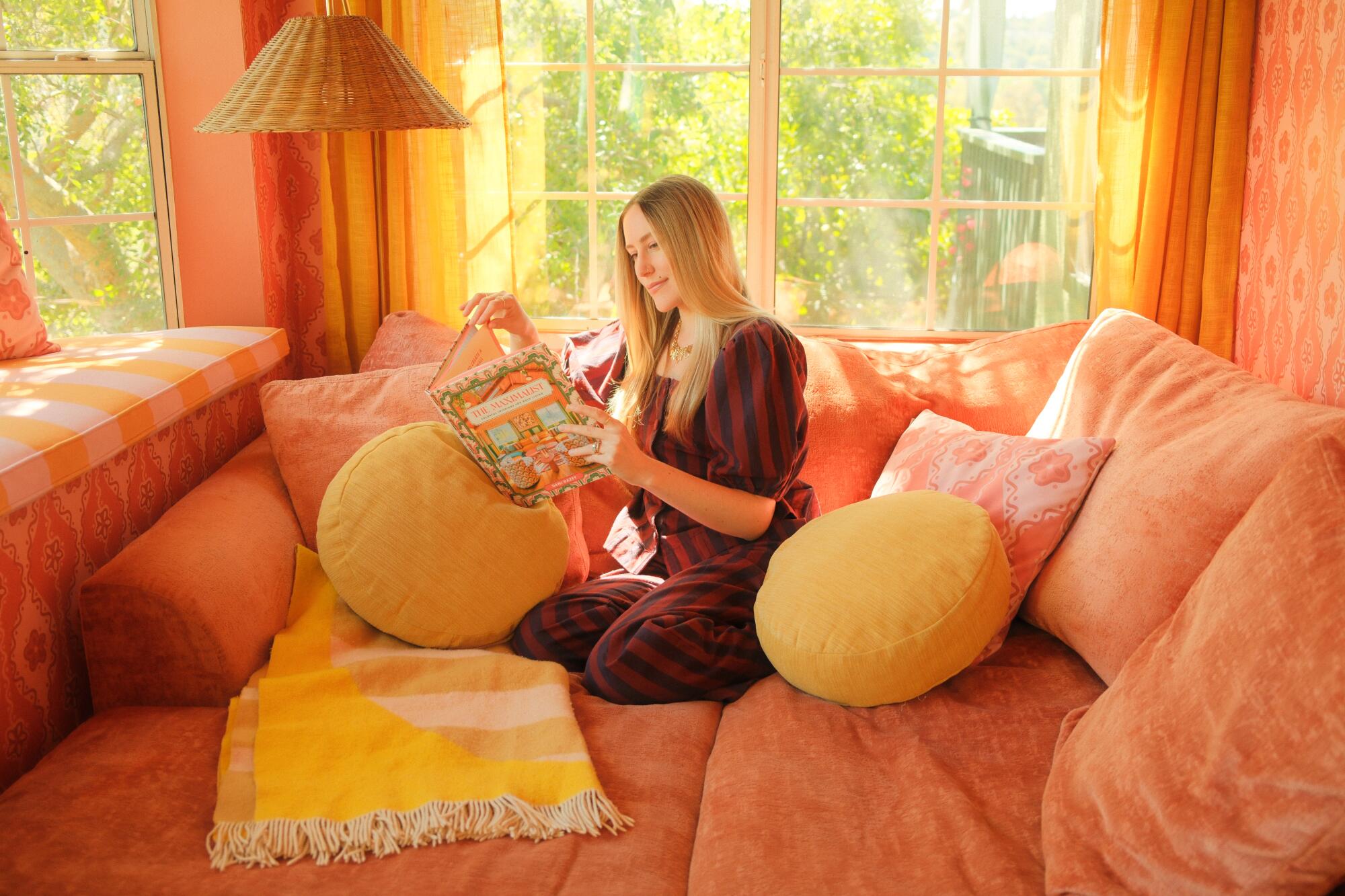
Dazey prefers to work on the pink velvet daybed that fits the alcove off of the living room like a glove.
The collaboration opened doors for Dazey, including an opportunity to design her first collection of home textiles and wallcoverings for Spoonflower and a furniture line for Joybird, which are featured in her home. It also attracted clients who appreciate her fun-loving aesthetic. She has since worked for Andy Hurley of Fall Out Boy and TikTok star Dylan Mulvaney. “I’ve been lucky to work for cool, interesting people,” Dazey said. “I think that people with a quirky sense of style and taste are interesting and dynamic.”
Despite her colorful interiors, Dazey knows what it’s like to struggle in a sterile work environment. “I used to work as an apparel graphic designer in a corporate office and didn’t feel inspired as a creative person,” she said. “When I went out on my own, I worked in coffee shops and I loved it.”
Today, she works out of a wall-to-wall pink velvet alcove covered in floral pink wallpaper and dog hair.

Dazey, pictured with Butler and their dogs Franklin and Yuki, believes in designing spaces that make people happy.
“I’ve designed some office spaces since then and try to make offices feel like a living room,” she said. “It can affect you creatively and inhibit your productivity. Now that I work from home, I love it.”
When asked what it’s like living with a maximalist, Butler said he trusts his wife’s instincts. “She went running with color when we got our first place together in Beachwood Canyon. It took a little arm twisting, but it all made sense when I saw it all come together. I learned to trust her process. There hasn’t been a single project where it hasn’t worked for me.”
Dazey, having shifted her focus from fashion design to creating happy interiors, sees the two processes as deeply transformative. “In my creative journey, whether it’s fashion or interiors, I’ve discovered the power of self-expression. It’s about defining who you are and sharing that with the world. The right outfit can change your entire day, just as the act of decorating your home can significantly impact your comfort, productivity and happiness. I love relaying that message — self-expression is more meaningful than aesthetics.”
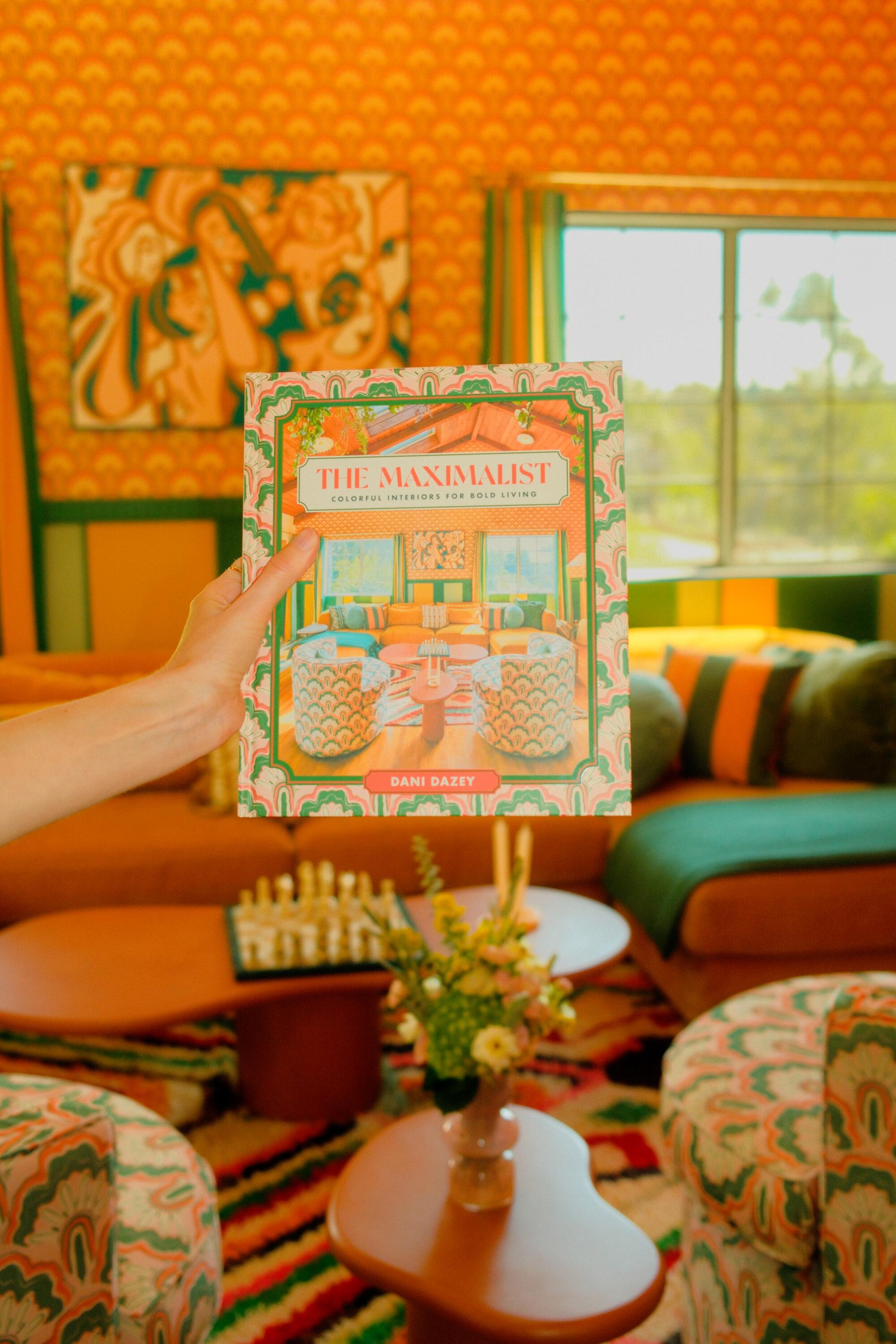
“The Maximalist” features 16 of Dazey’s design projects, including several that have never been seen before, such as a colorful mansion in Alabama.
(Excerpted from “The Maximalist: Colorful Interiors for Bold Living,” Abrams).
The old one-two punch
When mixing prints, I always like to think of a primary and secondary print. The primary is the main character print, which is more complex and illustrative. The secondary is the companion print — something less bold and usually a different scale.
Get some plants already!
A houseplant adds color and makes a space feel more homey without making any drastic changes to any of the walls. Plants breathe literal life into a space and help it feel complete. If your rooms don’t have any greenery in them, get yourself to your local plant shop — stat!
Make your home a gallery
This house is bursting with my personal design — and it feels so good. People are often hesitant to display their own artwork, but I say use the walls of your home to broadcast your creativity.
Stripes cut sweetness
I designed some almost-old-fashioned floral wallpapers for this house, but they’re often purposefully paired with a stripe. A strong, graphic pattern, like a stripe or a check, has the power to temper the sweetness of a floral-y-print.
Double the fun
Half walls abound in this home because I wanted to max out my opportunities for pattern and color play. Adding a half wall to a room in your home is a great way to start experimenting with design on a more complex level.
Appreciate the bedroom set
Matching bedroom sets have a very 1980s reputation (and not in a good way!), but if the furniture is cool, a coordinate set can be a smart strategy to help a maximalist bedroom feel more uniform.
Reconsider wall-to-wall
I am predicting a carpet comeback. People love rugs, so why not consider a completely carpeted room? Everything in design circles back around, and I think wall-to-wall is due to be done in a new way.